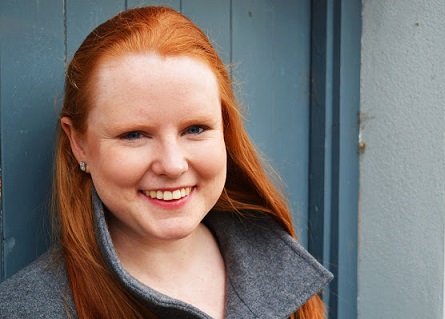February 27, 2018
Dialogues de Carmélites at the Guildhall School: spiritual transcendence and transfiguration
This new production which Martin Lloyd-Evans has devised for the postgraduate opera students at the Guildhall School may share some of Carsen’s and his designer Michael Levine’s visual minimalism but it is altogether a calmer, more intimate affair. Lloyd-Evans, conductor Dominic Wheeler and the young cast pay great respect to this challenging work: it is no mean feat to sustain a pretty well unrelievedly intense mood for so long, so effectively.
The production team achieve this through a combination of period-specific detail, simple iconographic statements by designer takis, and Robbie Butler’s striking lighting design, which work collectively to both link the tableaux-like episodes of Poulenc’s narrative and allow space for symbolic gesture. Poulenc’s Stravinkian ostinatos injected momentum into the unfolding rituals. Admittedly, though, spiritual serenity can be achieved at the expense of inflamed passions, and some of the crowd scenes fell a little flat, lacking a palpable sense of menace and terror.
And, though the Guildhall School tackled Poulenc’s opera just seven years ago, it does seem a strange choice for a student production given that there are so few roles for the men - and for those chaps taking those roles that do exist there is not much time to establish credibility of character - and that even the plentiful prioresses are seldom individualised. Moreover, the grandeur of the choral scenes might seem to require more forces and funds than the average music college can muster.
Commissioned in 1953 by La Scala, Dialogues des Carmélites is based on a play by Georges Bernanos which dramatises the experiences of a neurotically anxious young aristocrat, Blanche de la Force, who, in search of spiritual peace and safety, leaves her family home at the beginning of the French Revolution to join the Carmelite order in Compiègne. But, the convent walls cannot keep out Revolutionary convictions. Blanche and her fellow sisters are arrested and while she initially flees from the oath of martyrdom that they have all taken under the guidance of the formidable Mère Marie, as her sisters embrace the ultimate sacrifice, Blanche returns to take her place at the scaffold.
What seems important, and what Lloyd-Evans and takis clearly appreciate, is that this is not an opera about the French Revolution. Indeed, I can’t find, or write myself, a better explanation of what the opera is ‘ about’ than this ‘explanation’ by Donald Spoto’s explanation in Opera News fifteen years ago:
‘It is rather a series of nearly classical dialogue-scenes in which issues and questions of deeply human and religious significance are set forth, explored and clarified. The key to its complex of ideas is to be found in certain matters of the faith that claimed the loyalties of Poulenc and of Georges Bernanos, whose lifelong motto was set forth at the end of his novel Journal d’un Curé de Campagne (Diary of a Country Priest, 1936): “Tout est grâce” - everything is grace.’ [1]
This concept is powerfully embodied in one line in the libretto, when the Le Prieure warns the overly fervent, naively self-righteous Blanche, who is seeking to enter the order, ‘Prayer alone justifies our existence .... we are bound to it day and night’. These words may be difficult for a non-believer to understand or empathise with, but they underpin the opera, and Lloyd-Evans’ production. The musical set-pieces of observance - the Qui Lazarum, Ave Verum Corpus and Salve Regine - are architectural linchpins in the unfolding sequence of tableaux through which the spiritual journeys of Blanche and Mère Marie is conveyed. During the performance I was reminded of the words of one of my colleagues, Anne Ozorio, who, writing of the last GSMD production in 2011 observed that, ‘Dialogues des Carmélites … unfolds as a series of disconnected tableaux, like the Stations of the Cross. This structure is significant, for Poulenc is connecting the nun’s journey to the guillotine to Christ’s journey to the cross. The narrative is deliberately stylized to emphasize the spiritual and moral implications of the plot. It’s not simple narrative.’
Various hanging flats - interior walls, marble edifices, grilles that evoke both confessional chambers and prison gates (and when florally decorated, garden trellises) - slide, diverge and re-form, at one point forming an air-borne Crucifix, and ultimately coalesce as a granite headstone memorialising the life of Blanche de la Force. The subtle movement and prevailing stillness expressed an unassailable spiritual nobility.
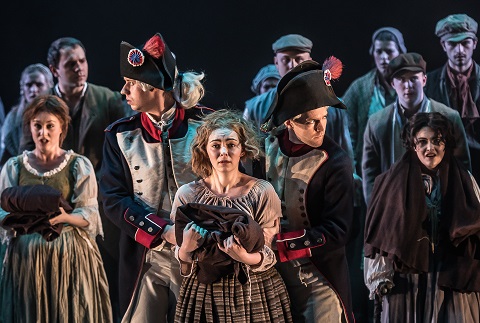 Claire Lees (Soeur Constance); Jake Muffett (1er Officer); Meriel Cunningham (Mere Gerald); Michael Vickers (Le Marquis); Eva Gheorghiu (Soeur Felicite). Photo credit: Clive Barda.
Claire Lees (Soeur Constance); Jake Muffett (1er Officer); Meriel Cunningham (Mere Gerald); Michael Vickers (Le Marquis); Eva Gheorghiu (Soeur Felicite). Photo credit: Clive Barda.
Lucy Anderson’s Blanche was fittingly unbalanced and febrile, and if at first, in the scene with Michael Vicker’s luxuriously costumed Marquis de la Force, her broad vibrato diffused the focus of the tone, then later, when paradoxically attired in humble habit, the rich layers of her soprano blossomed with lyric intensity. I was pleased, too, that the oft-cut spoken scene, which links the final conversation between Marie and Blanche and the assembling of the nuns in their prison cell, was retained. Blanche’s street encounter with citizens who tell her of the arrest of the nuns and are astonished by the emotive response of this ‘servant’ who declares she has never been to Compiègne, is pivotal to her remorseful acceptance of her place beside her sisters at the scaffold.
Chloë Latchmore’s Mère Marie was superbly acted and sung. She movingly conveyed the spiritual misunderstandings that this fervent but sometimes misguided nun must face, and her struggle to truly understand the new prioress’s guidance that, ‘It is not up to us to decide whether our names will later appear in a list of martyrs’ was deeply affecting. Latchmore has a strong middle voice but can also project convincingly at the top, whatever the dynamic; this was an utterly convincing vocal and dramatic performance.
Georgia Mae Bishop threw her all into the Prioress’s all too human fears of death (though the quasi-Gothic blue/black eye-shadow was perhaps a supernatural step too far). Claire Lees captured Sister Constance’s gaiety and unpretentious spiritual vision. The French diction of the entire cast was exemplary.
Dominic Wheeler’s direction of the Guildhall School's instrumentalists reminded me how sympathetic and helpful Poulenc’s orchestral writing is to the voices: at times the orchestral fabric becomes a huge organ-like tapestry, supporting their arioso lines. Elsewhere, the strings in particular conjured an almost Tchaikovskian lyricism and ardency, while finely delineated woodwind playing was complemented by warm and pretty reliable horns.
With the first UK performance of Jake Heggie’s Dead Man Walking (at the Barbican Hall last Tuesday) fresh in my mind, the obvious narrative parallels with Poulenc’s opera seemed strong. But, in Dialogues, the spiritual mysteries are in the music itself, something which to me seemed lacking in Heggie’s score, and Wheeler did much to communicate the ambiguities and conflicts.
Much, of course, rests upon the opera’s final scene. Some might have wished for more melodrama than Lloyd-Evans offered, but, for me, this opera is about sacrifice - a journey through fear of death to faith in martyrdom - and this needs no grand gestures. Earlier in the opera, the second prioress confronts the Revolutionary Officer who comes to arrest the nuns, and who taunts their readiness to remove their religious habits: ‘Your uniform does not make you a soldier.’ And, while Lloyd-Evans’ closing gesture pays a nod to the opening image of Carsen’s production - of neatly folded habits decorously arrayed across the ROH stage - as each of the nuns stepped forward and placed her brown habit on the ground, and the shocking swishing of the guillotine sent shudders through the instrumental texture, we understood that this humble ‘offering’ was a sign of spiritual serenity and transcendence.
Claire Seymour
Poulenc: Dialogues de Carmélites
Blanche - Lucy Anderson, Le Chevalier/Premier Commissaire - Daniel Mullaney, L’Aumônier - Eduard Mas Bacardit, Le Marquis - Michael Vickers, Premier Officer - Jake Muffet, Le Prieure/Mère Jeanne - Georgia Mae Bishop, Soeur Constance - Claire Lees, Mère Marie - Chloë Latchmore, La seconde Prieure - Michelle Alexander, Soeur Mathilde - Lucy McAuley, Deuxième Commissaire/Theirry/M.Javelinot/Le Geôlier - Bertie Watson; director - Martin Lloyd-Evans, conductor - Dominic Wheeler, scenography and costume designer - takis, lighting designer - Robbie Butler.
Guildhall School of Music and Drama, Silk Street, London; Monday 26 th February 2018.
[1] Donald Spoto, ‘Dialogue on Carmélites II: A Roman Catholic's Perspective’, Opera News, Jan 2003, Vol. 67, Issue 7.
Photo credit: Clive Barda
'B & B’ in a new key
But as any scientist will tell you, an experiment that fails is as invaluable as one which comes off. As such, again, Seattle’s show is quite a success. We now have strong evidence that a number of plausible approaches to“fixing” B&B just don’t work.
The overarching problem with opéra comique today, even in France, is its incorporation of substantial passages of spoken dialogue. The theater for which almost all the traditional Parisian opéras comiques were written contained 1,100 seats. The newly-restored house, which opened in April 2017, only 100 more.
The Susan Brotman Auditorium of Seattle’s Marion McCaw Hall seats 2,900: more than 260% larger. A human voice, no matter how well-trained, cannot be understood from its stage without amplification. Even with amplification, the performers’ diction must be perfect to be comprehended, and the disproportion between great big voices and the tiny figures producing them creates a sense of eerie alienation rather than intimacy.
So: bottom line—B&B doesn’t fit this room and never will. But Seattle Opera’s production team couldn’t accept that. They wanted to do the show, period. And they convinced themselves that with enough tweaks and kludges it could be made to fit.
Tweak number one: the spoken dialogue is amplified, with just the effect it always has on the operatic stage: a clumsy jolt to the ear every time the music starts or stops.
Tweak number two: the opera is performed in English throughout, only the sung portion is supertitled, which only emphasizes how poorly one understands the dialogue when the mikes come back on.
Tweak number three: the perfectly serviceable dialogue Berlioz himself created to span the scenes between numbers with scraps of gen-yew-ine 100% Shakespeare, whose words can be hard to follow when spoken at speedby fine actors in an auditorium designed for spoken theater.
Not content with those additional challenges, they have restored scenes and characters cut by Berlioz, requiring an additional half-dozen speaking actors and 20 minutes more dialogue, most of it dry and expository. The only character Berlioz invented for his version, the tedious music master Somarone, is rendered somewhat less tiresome by giving him comic lines taken from Shakespeare’s constable Dogberry. To smooth the bits where the talk gets to be too much even for the innovators, they innovate some more, suturing in music from other Berlioz works including little tune-clips for underscoring.
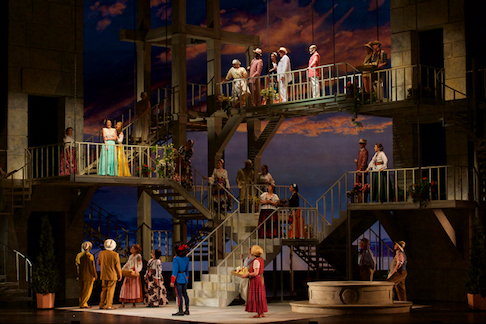 Entire cast (singers and actors)
Entire cast (singers and actors)
Overall it is a triumph of artistic perversity, and the physical production amplifies the torment for all concerned, with a stage-filling M.C. Escheresque assemblage of industrial-strength staircases leading to landings with no function. Sicily’s torrid Messina has never looked chillier.
Considering the unnecessary handicaps imposed on them, it’s a wonder the performers manage to survive at all. But Shakespeare’s play, and the characters of the squabbling titular lovers, are apparently indestructible; assoon as they are in charge, you can feel the musing audience come alive again. The laughs are real, not forced; the drama soars.
As the secondary pair of lovers Hero and Claudio, carried their weight but set no fires. Laura Tatulescu, a notably saturnine Despina in Seattle Opera’s recent Così, was a little colorless dramatically, even for the colorless-virgin character she was playing, but she sang appealingly, especially in the duet with her companion Ursule (Avery Amereau, a superb supporting performance). Craig Verm, the boisterous-bro Ferrando of Seattle Così, contributed fine vocalism to his ensemble numbers but was strangely subdued as Hero’s jealous lover; even with the advantage of an interpolated revenge number (from Berlioz’s Benvenuto Cellini) he seemed utterly unengaged with the role.
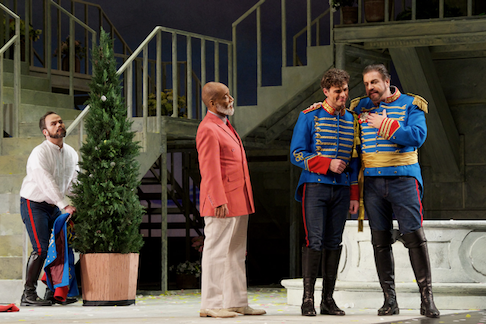 Andrew Owens (Benedict), Marvin Grays (Leonato), Craig Verm (Claudio), and Daniel Sumegi (Don Pedro)
Andrew Owens (Benedict), Marvin Grays (Leonato), Craig Verm (Claudio), and Daniel Sumegi (Don Pedro)
But like the play, the whole show depends in the end onthe two principal singers’ gifts, and on Sunday afternoon we had a pair of pippins. Andrew Owens, bushy of beard and bouncy of demeanor, sings Bénédict’s busy, declarative music with brio; he has a sharp comic sense which enlivens his every scene. Most astonishingly, when forced by the director to climb the eternal stairs backwards, does it with élan.
Hanna Hipp, a Rossinian mezzo with the chops to take on Strauss’s Composer in Ariadne auf Naxos, was queen of the evening. Her sung and spoken English a model for everyone else on stage, her character, sprightly, furious, and rueful by turns, never let the moment down and bumped up the energy whenever it sagged.
The unobtrusive accompaniment of conductor Ludovic Morlot provided the most important support for the whole evening. The departing music director of the Seattle Symphony has particularly excelled in French repertory, and he excelled equally with the idiosyncratic chiaroscuro of Berlioz’ orchestration and the firmly traditional structure pacing of his arioso.
I’m glad to have had a second chance to see B&B live (the first was one streamed from Glyndebourne last summer). And though this ambitious remodeling turned out about as unsatisfactory as can be imagined, I feel I’ve learned two things about the piece. It is viable; but even in French we need to recognize that in opera houses as large as most in America, an all-sung version it the only way to go. I’m sure that Carmen was wonderful in its original opéra comique form; but does anyone really want to go back to regularly performing the original?
I don’t believe it. And if that’s the case, can’t we consider setting the spoken parts of B&B as “accompanied recitative,” as Ernest Giuiraud did for Bizet’s work? Isn’t there enough vocal music by Berlioz to allow a gifted pasticheur material for matching? What a shame we didn’t ask Stephen Sondheim to take a look at the job years ago.
Roger Downey
Cast and production information:
Cast (singing roles only): Daniel Sumegi (Don Pedro); Kevin Burdette (Somarone); Avery Amereau (Ursule); Craig Verm (Claudio); Laura Tatulescu (Hero); Andrew Owens (Bénédict); Hanna Hipp (Béatrice).Conductor: Ludovic Morlot; Stage director: John Langs; Scenography: Matthew Smucker; Lighting: Connie Yun; Costumes: Deborah Trout. John Keene: chorus
image=http://www.operatoday.com/B&B_Seattle1.png
product=yes
product_title=Béatrice et Bénédict at Seattle Opera
product_by=A review by Roger Downey
product_id=Above: Andrew Owens as Bénédict), Hanna Hipp as Béatrice [All photos copyright Jacob Lucas, courtesy of Seattle Opera]
February 26, 2018
Songs for Nancy: Bampton Classical Opera celebrate legendary soprano, Nancy Storace
Anglo-Italian soprano Ann Selina (Nancy) Storace (1765-1817) was renowned for her vocal prowess and remarkable stage presence, enjoying a glittering career across Europe. Recruited for Emperor Joseph II’s new Italian opera company, she dazzled audiences in 18th-century Vienna and enthralled the leading composers of the day; not least one Wolfgang Amadeus Mozart who created the role of Susanna in Le nozze di Figaro specifically for her.
Nancy’s father, Stefano, originally from Naples, was a professional double bass player in London and Dublin. He recognized the talent exhibited by his eight-year-old daughter, who could sing sweetly and sight-read effortlessly, and nurtured her precocity - perhaps, some have suggested, at the price of a long-lived career. In August 1773, she appeared in Hampshire with the violinist Ximenez, and their concert was so successful that a repeat was demanded. (So, Stefano left his young daughter alone in Southampton, while he travelled to Worcester to perform in the Three Choirs Festival!) [1]
Stefano arranged for Nancy to study in London with the Italian castrato and composer Venanzio Rauzzini (1746-1810) and, at the age of eleven, she took a minor role in his opera, L’ali d’amo. Two years later, she and her parents travelled to Italy to join her brother Stephen, a composer, and immediately she impressed in Naples and Florence. She was not yet sufficiently wise to the profession’s games and pitfalls, however, and found herself sacked from the Florentine Pergola Theatre, after she offended the castrato Luigi Marchesi whose vocal tricks she dared to effortlessly imitate.
The Storaces travelled to Lucca, Leghorn (where she met life-long friend, the Irish tenor Michael Kelly), Milan, Parma and Venice. Success, and wealth, seemed hers for the taking. An Imperial talent scout, Count Durazzo, snapped her up (along with Kelly) and Nancy found herself installed as prima donna of opera buffa at Emperor Joseph II’s Burgtheatre. By 1782, at the age of just seventeen, she was undoubtedly a European star.
Nancy’s ambitious mother encouraged her to marry the wealthy violinist and music scholar, John Abraham Fisher, who was more than twice her age. Fisher’s threatening, violent behaviour led the Emperor to order his exile, and thereafter there was much speculation about Nancy’s private life - was she the mistress of Mozart, or even the Emperor? In February 1787, following a quarrel between Kelly and a Bohemian officer, and Stephen Storace’s drunken antics at a ball, the Storace clan returned to London. Nancy had caught the eye of the young English aristocratic Lord Barnard, and after they had travelled homeward together he attended the performance which marked her return to London: a royal gala performance of Paisiello’s Gli schiavi per amore (The slave of love) at the King’s Theatre Haymarket on 24th April 1787 London, that was attended by the Prince of Wales. Yet, just three months later, Barnard had deserted Nancy and married.
She maintained a discrete liaison with the Jewish tenor John Braham, nine years her junior, with whom she toured Europe in 1797. Although they could not marry (as Fisher was still living, until 1806), they set up house and a son, William Spencer Harris Braham, was born on 3rd May 1802.
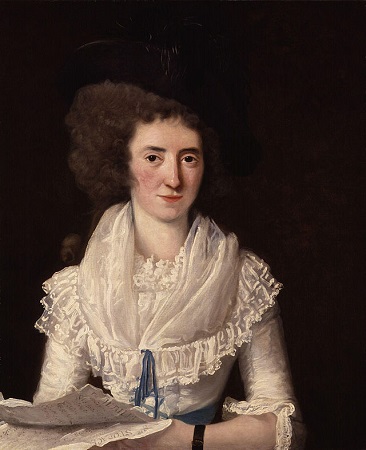 Anna Selina Storace (c.1790) by Benjamin Van der Gucht (1753-1794) from the Collection of the National Portrait Gallery.
Anna Selina Storace (c.1790) by Benjamin Van der Gucht (1753-1794) from the Collection of the National Portrait Gallery.
During these years, Nancy’s voice was beginning to fade and, while her acting abilities continued to be praised, in 1801 the Times noted that her voice was ‘occasionally affected by a little hoarseness’; the same year the Chronicle suggested that ‘she would do more … if she attempted to do less’. [2] Nancy retired in 1808: her farewell to the stage was her brother’s No Sing, No Supper, alongside her old friend Kelly. Her relationship with Braham deteriorated - he eloped at end of 1815 with Sophie Wright, who had been a close friend of the couple - and she died in 1817 in Dulwich.
So, was Nancy was one of the 18th century’s operatic darlings? Or, as one scholar has suggested, was she ‘exploited not only by theater managers and impresarios, but by family and friends as well, who used her for their own purposes.’ [3]
Bampton Classical Opera marks the bicentenary of Nancy’s death with a fascinating concert of music associated with her, including arias sung by sopranos Jacquelyn Stucker, currently a Jette Parker Young Artist at the Royal Opera (whose roles this season include Azema ( Semiramide ), Countess Ceprano (Rigoletto) and Frasquita ( Carmen )) and Rhiannon Llewellyn, who sang the role of the Countess in the company’s production of Salieri’s The School of Jealousy last year. The performance will be conducted by Andrew Griffiths, a graduate of The Royal Opera’s JPYA Programme. The concert brings together a number of significant works with which Nancy was linked.
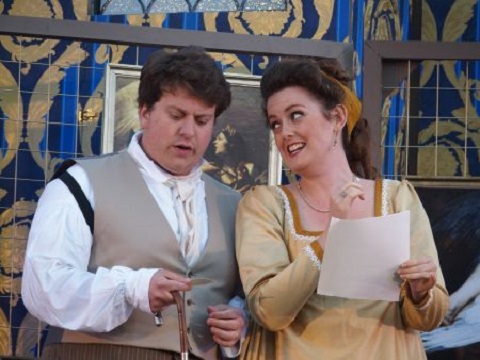 Alessandro Fisher (Count) and Rhiannon Llewellyn (Countess) in Salieri’s The School of Jealousy, Bampton Classical Opera, 2017.
Alessandro Fisher (Count) and Rhiannon Llewellyn (Countess) in Salieri’s The School of Jealousy, Bampton Classical Opera, 2017.
I spoke with both Jacquelyn and Rhiannon as they prepared to inhabit the legendary soprano’s shoes. I was interested in whether young singers training today are taught about, or consider, past singers and historic contexts? For example, if one is learning the role of Susanna, does one reflect on the first performance and the role’s initial interpreter?
Jacquelyn explained that, while she could not speak for all young singers, “looking up the soprano who premiered a role that interests me is how I discover new repertoire, particularly for Baroque and Classical works. I do think that the way we sing now is different from the way singers would sing in the past - for example, the most powerful part of a soprano’s voice in Handel’s heyday was right in the middle of the staff, which is why the A sections of his da capo arias always feature a cadence right in the middle of the soprano vocal range. Ask most sopranos singing now about their middle voice (myself included!), and I’m willing to bet that you’ll get a variety of responses: an eye-roll, a shrug, perhaps some self-effacing laughter.
“And, here’s why: in terms of modern technique, it can really be a temperamental part of the voice, whereas the voice at the top of the staff is much more secure for sopranos [which also, she explains, relates to how instruments and orchestras have changed]. To address this, sopranos now often ornament these final cadences into the highest parts of their range - it’s in the spirit of what Handel intended, but it accommodates modern technique. So, I think taking a few minutes to be aware of the singer who created a role is always wise as an awareness of what has been done before can serve to inform our own choices. However, times and expectations and techniques have changed apropos how we study and listen to and execute works in the Western canon, and the only way to possibly add something to the larger artistic discourse is to use our unique voices to declaim the text as truthfully and as diligently as we can.”
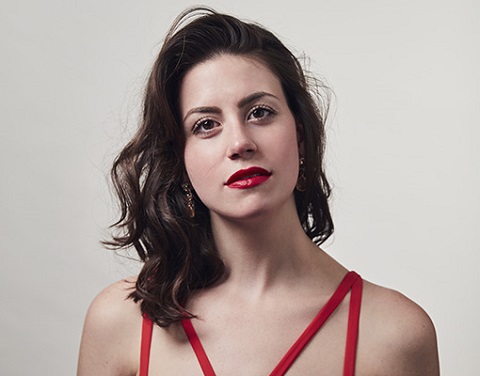 Jacquelyn Stucker. Photo courtesy of IMG Artists.
Jacquelyn Stucker. Photo courtesy of IMG Artists.
Obviously ‘career paths’ are very different today … but, I wondered whether the challenges that singers such as Storace faced bore any resemblance to the hurdles that young professionals today have to climb? Interestingly, both Jacquelyn and Rhiannon were keen to emphasise some of the factors and circumstances that had stayed the same or changed only a little. For Jacquelyn, “Performing new music is a huge part of my professional life, and it sounds like it was an important part of Nancy’s as well! This programme of music written especially for Nancy Storace has reaffirmed for me how important it is for singers of any generation to collaborate with living composers and perform new music. In my experience, composers enjoy writing music that singers want to sing, that feels good to sing - seeing how Haydn, Stephen Storace, Salieri, and Mozart all achieved this within their own musical language only reaffirms for me how productive and creative the composer-singer relationship can be.”
Interestingly, Jacquelyn is currently preparing for a solo recital presented through the Jette Parker Young Artist Programme which comprises three large works: one UK premiere, one European premiere, and one world premiere - and, two of the three composers featured on the concert are travelling to London from the US to attend the recital. The recital is entitled Fragments of Life: Songs of Loss, of Memory, of What Happens Next, and Jacquelyn’s excitement at being able to bring works by Federico Favali, John Harbison, and Mark Kilstofte to the London music scene is clear. The performance is at 1pm at St. Clement Danes on The Strand on Monday 26 th March, and admission is free - “And, really, when else would you get to hear a world premiere on your lunch break?”
Is the need for present-day singers to ‘promote’ themselves via social media etc. actually quite similar to Stefano’s promotion of his daughter, albeit in different contexts? And, Nancy was propelled into the limelight at such an early age: not so different from some modern child-stars, perhaps?
Jacquelyn remarked, “I cannot even imagine the pressure she must have been under! I also read that she had a unique and vibrant personality, so a part of me thinks she was, even at such a tender age, up for the challenge of being in the public eye for a significant part of her adolescence.
“My perspective on this subject is heavily influenced by my experience as a singer trained in the United States, but I do think there is a similar pressure on singers now to promote themselves: get the ‘right’ headshots, make a ‘proper’ website, matriculate into the ‘posh’ YAPs - to curate a public image, a brand, a pedigree. In my opinion, there is less pressure to do this here in the UK, but there is significantly more pressure to really say something artistically in a powerful way every time you open your mouth to sing. There is also more demanded of singers in terms of their dramatic ability. I fully admit that my view of this profession is more narrow than I’d like it to be, but these are the honest impressions I have based on working in both of these countries. Truth be told, I’m grateful for both approaches to modern professionalism. I think they are essential to becoming a well-rounded modern performer-entrepreneur, which is the global expectation at large, as I perceive it, for young singers.”
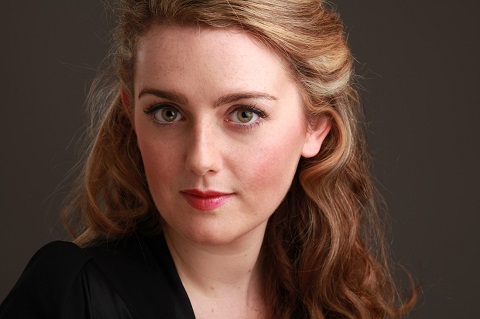 Rhiannon Llewellyn.
Rhiannon Llewellyn.
Then there’s the question of needing to travel to develop and nurture a budding career. While it must have been much more taxing in a practical, and financial, sense in the eighteenth century, it never ceases to amaze me how singers today seem to have to whizz, exhaustingly, around the globe at the drop of an audition-invitation.
Rhiannon agreed that there are some similarities but noted that one essential difference is that to travel to from London to Vienna in the late-eighteenth century was no casual enterprise: one needed not inconsiderable money and time. The Storaces’ journey to Europe took months of planning and fundraising. And, once you had arrived, you stayed put. Nowadays, singers are constantly receiving last minute calls to travel to Oslo or Zurich or further afield to undertake auditions, the outcomes of which are uncertain. “It sometimes feels as if one is constantly gambling.”
Storace and Cornetti are really just ‘names from history’ today; audiences have little knowledge of or familiarity with their music. As a singer, is there a difference in the way that one prepares such repertoire? Jacquelyn observed, “My approach to repertoire is always the same no matter if the piece is well-known or not: I always start with the most complicated element, which is (based on the repertoire I tend to sing) either the words or the rhythms. I always like to cmemorize the poems and speak them to myself constantly. (It drives my husband totally crazy.) Then, I work out the notes as much as I can away from the piano. Sight-singing the vocal part helps it stick in my brain better, for some reason - I think it helps me work out how the piece is organized, and understanding form is how I memorize pieces. I like having one approach for everything I sing - it makes assimilating music much faster; I have a technique that works, and I apply it every time. It took me a few years to figure out my method, but this has worked for me over the past three years.”
One among many of the less familiar and more intriguing works on Bampton’s Storace programme is the cantata Per la ricuperata salute di Ofelia, which, I think, is receiving its first full performance since it was presented with harpsichord accompaniment in 2016 , following the rediscovery of a printed score from 1785 in the archives of the Czech national music.
The title of the cantata (‘For the recovered health of Ophelia’), for which Lorenzo Da Ponte wrote the libretto, derives from the work’s origins. It was designed to celebrate Storace’s recovery after a ‘vocal crisis’ at the age of nineteen forced the singer to retreat from the stage for four months. Chancellor describes how, in June 1785, Nancy suddenly lost her voice at the beginning of the premiere performance of her brother's opera Gli sposi malcontenti: ‘Though it was then tactfully rumored that this resulted from the emotional stress of an unhappy marriage, it is much more credible that the strain of being eight months pregnant—her child died soon after birth the following month—and the added stress of an appearance before the emperor and the Duke of York, then on a state visit, while she was suffering from a throat infection, were the real causes of the disaster.’ [4] Her return to the stage seems to have brought about a collaboration between composers, Salieri and Mozart (and the little-known Cornetti), so often considered bitter rivals.
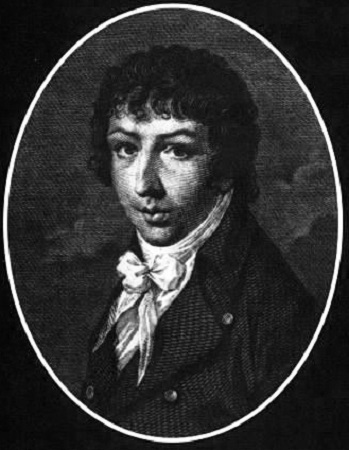 Stephen Storace.
Stephen Storace.
Jacquelyn considers the music of Per la ricuperata salute di Ofelia as “anything but dramatic or florid, in my opinion! It is balanced, it embraces simplicity, and it has a bit of a wide compass in the vocal line, much in the way ‘Deh, vieni’ [which she is also performing in the Bampton programme] does. In practising this work, I’ve decided that its charm lies in how exposed it is for the singer, and how well the singer can simply sing a beautiful legato line.
Interesting, Rhiannon makes similar observations about another contemporary ‘hit’, written especially for Nancy by Martin y Soler: ‘Dolce mu parve un di’ from Una cosa rara, finding the aria lyrical and sensuous. Jacquelyn also remarks that ‘Deh, vieni’ and the role of Susanna in general “does not sit particularly high in the voice - which is what Nancy was known for, from what I’ve read”. Rhiannon - who has recently been singing the role of the Countess in Figaro, with The Merry Opera Company, similarly finds ‘Porgi amor’ beautiful but quite low-lying. She added: “Look at the roles she sang! Despina is a pretty, party-girl, who doesn’t take things too seriously. I think that this was Nancy … it was, and is, okay to be a little irreverent at times!”
Jacquelyn agreed, “I am of the opinion that Susanna [Figaro] was modelled more after Nancy’s personality than her instrument, and I think that’s kind of fantastic. Whether or not this is accurate, I love thinking that a composer would write a piece for a singer as a human being with a voice and not just a voice with a personality attached.” Similarly, Rhiannon suggested that the music written for her confirms that Nancy Storace must have first and foremost been a terrific actress - this might explain some of the vocal writing, which is almost “nonsensical at times!”
Mozart’s ‘Ch’io mi scordi di te’ was written for Nancy’s farewell concert in Vienna which took place on 23rd February 1787 (with Mozart playing the piano obbligato part). I asked Jacquelyn if she sensed her predecessor’s vocal strengths and qualities in this concert aria? Is this aria, and the role of Susanna, a ‘tribute to her talent’?
“Absolutely. Nancy was known earlier in her career for her amazing high notes, but she must have had, in the later stages of her singing life, truly remarkable command over her lower passaggio (which is, for us lighter sopranos, a tricky part of the voice). This concert aria also places the text in the middle of the voice, which means articulating the words is much easier than in other concert arias Mozart wrote. Because of this, it’s clear to me that Nancy must have been a dynamic performer with an unshakeable commitment to text. She definitely left some big shoes to fill, but I love knowing that Mozart wrote this amazing music for a spitfire of a woman who also happened to be an amazing musician.”
Claire Seymour
Bampton Classical Opera, Songs for Nancy: St John’s Smith
Square, 7th March 2018, 7.30pm
Jacquelyn Stucker and Rhiannon Llewellyn (sopranos), Andrew Griffiths
(conductor and piano), CHROMA
Concert programme: Sarti - Fra i due litiganti il terzo gode, Overture; Mozart - Le nozze di Figaro, ‘Giunse al fin il momento … Deh vieni’; Stephen Storace - No song, no supper, Overture & ‘With lowly suit’; Salieri - La scuola de’ gelosi, Overture & ‘Or ei con Ernestina … Ah sia già de’ miei sospiri’; Haydn - Cantata, Miseri noi, misera patri & Symphony No.83 (‘The Hen’); Martin y Soler - Una cosa rara, ‘Dolce mi parve un di’; Mozart, Salieri, Cornetti - Cantata, Per la ricuperata di Ofelia; Mozart -‘Ch’io mi scordi di te’ K505.
[1] See V.E. Chancellor, ‘Nancy Storace: Mozart’s Susanna’, The Opera Quarterly, Volume 7, Issue 2, 1 July 1990: 104-124.
[2] Isabelle Putnam Emerson, Five Centuries of Women Singers (Praeger, 2005)
[3] Chancellor, op.cit., p.105.
[4] Chancellor, op.cit., p.107.
February 25, 2018
Tenebræ Responsories
recording by Stile Antico
The varied programming is the disc’s greatest strength, with the inclusion of a six-voice motet and excerpts from the Lamentations showing a mindfulness to provide listeners with textural and harmonic contrast. However, this is a competitive market, with a critically acclaimed recording from Tenebrae under Nigel Short, not to mention a warm and thick-textured account by The Sixteen under Harry Christophers. This new release brings plenty of imagination in the programme, but the performances of the Responsories themselves - whilst engaging and persuasive - may struggle to add anything over their competitors.
The Responsories are all about darkness; in the 16th-century in which Victoria was writing, the service would have concluded in total darkness, as the candles representing Christ, the Disciples and the three Marys were gradually extinguished during the service (‘Tenebrae’ is the Latin for darkness). Stile Antico convey the bleakness of the text well, using men’s voices alone in ‘Tenebrae factae sunt’ and ‘Aestimatus sum’; the darker hue of the bass singers is particularly striking here, conveying the pain and despair of the text. Indeed, it is a tradition that, in performance, a selection of the Responsories for upper voices are instead performed by the lower ones; whilst enabling a more vivid portrayal of the text, it also allows for contrast with the SATB scoring of the other Responsories.
Contrast is vital in the Responsories, as a danger of Victoria’s setting is monotony; all eighteen Responsories use the same mode, and similar three or four-part textures. Thus, the reversion to male-only voices for two of the Responsories creates an edifying contrast that makes it more comfortable to listen to the full disc in one sitting. Further contrast is created by the admirable inclusion of Victoria’s six-voice motet ‘O Domine Jesu Christe’ at the end of the disc, in which the more adventurous harmonies provide an interesting snapshot into the broader musical language of this Renaissance master. Equally interesting is how the disc intersperses excerpts from the Lamentations readings, sung to a plainchant setting; given that the broader Liturgy in which the Responsories appear would have been dominated by plainchant, such works provide a useful context for Victoria’s polyphonic Responsories. Such variety creates an imaginative and elegant programme that is perfectly enjoyable in a single sitting.
Contrast within the Responsories themselves is, however, slightly lacking. A mezzo forte dominates the Responsories, with the portrayal of the “innocent lamb” in ‘Eram quasi agnus innocens’ finding much the same dynamic as the presentation of the “hanged man” in ‘Amicus Meus’. Surely greater nuance could be found between these two starkly opposed images, connotations and emotions? Although one mood pervades all eighteen Responsories, the text includes some striking oppositions, contrasting good with evil, and peace with violence. Such varied images - even if united by a common emotion - deserve more nuanced treatment.
Within individual Responsories, too, there lacks dynamic subtlety; although ‘Una hora’ opens with a delicate hush courtesy of a solo voice, as soon as the choir enters, one yearns for greater dynamic nuance. Such gradations are only more important given how the text sustains a single mood.
Having said this, Stile Antico perform with great clarity of diction and purity of line. Take, for instance, the immediate solo opening of ‘Una hora’; the plaintive simplicity of the solo line contrasts with the distracting vibrato of the soloist in Schola Antiqua’s 2005 recording. However, this section also provides a useful example of how, like the disc more broadly, this new release offers a pleasant reading but nothing that adds a great deal to its numerous rivals; Ensemble Corund feature a striking crescendo on the opening note of ‘Una hora’, something that maintains the purity of the line but also imbues it with greater dramatism and weight. Both Tenebrae and Stile Antico opt for stillness instead, which communicates melancholy but arguably at the expense of drama.
Stile Antico’s acoustic allows for greater clarity and delineation of lines in ‘Animam meam dilectam’, in comparison to Tenebrae. Such a keen sense of interweaving voices is vital given that the Responsories form part of a much longer liturgy, the majority of which would have been performed to plainchant; as such, Victoria’s polyphony would have provided noticeable contrast within the broader liturgy, a fact that Stile Antico are keen to emphasise through their own clarity of line and texture.
The programming of this release is its greatest strength, with the inclusion of excerpts from the Lamentations readings as well as the concluding motet providing both engaging contrast and useful context for the Responsories as part of a longer liturgy. The performances are dark and powerful, with the use of lower voices alone for selected Responsories a striking way of illustrating the darker texts. However, the relative dynamic uniformity of the Responsories reduces the dramatic power of the text. Overall, these are engaging performances, but with strong competition from Tenebrae in particular, they are a pleasant alternative, if not a game-changer.
Jack Pepper
Recordings:
Nigel Short, Tenebrae, 2013, Signum Classics
Harry Christophers, The Sixteen, 2011, Coro
Juan Carlos Asensio, Schola Antiqua, 2005, Glossa
Stephen Smith, Ensemble Corund, 2006, Dorian Recordings
image=http://www.operatoday.com/Pepper_Tenebrae.png
product=yes
product_title=Tomas Luis de Victoria : Tenebrae Responsories : Stile Antico
product_by=A review by Jack Pepper
product_id=Harmonia Mundi HMM902272
Digital Release: March 9, 2018
CD Release: April 13, 2018
Mahler Symphony no 9, Daniel Harding SRSO
A graceful first movement, respecting the marking andante comodo "comfortable pace". The harp and strings here have a mellow richness which enhances the gentle rhythmic pulse. For "pulse" this is, suggesting the human body at rest, calmly breathing. Gradually the palpitations build up towards expansive outbursts, as if invigorated by the flow of life. When silence descends, marked by timpani ans strident brass, the effect is chilling. The harp ruminates, and the steady pace resumes. The music flares up again : tension, alarm and a spiralling descent into darkness, and a wall of mournful winds and brasses. Yet again, though, steadiness prevails. Celli and bassoons lead the way ahead. Harding shapes the flow by highlighting the fanfares, so the undertow can be heard without undue exaggeration. Now, when relative silence returns, the mood is pure and calm: the high, clear pitch of the woodwinds is exquisite, evoking, perhaps, memories of summer, a typical Mahler touch.
Thus we are prepared for the second movement, marked "Etwas täppisch und sehr derb".(rustic, simple, earthy). Why Ländler in a symphony some still associate with death ? Ländler are danced by peasants who till the soil, who know that seasons change and that harvests return after fallow times. This movement is much more than folklore : it connects to the theme of change and rebirth that runs through so much of Mahler's work. The Swedish Radio Symphony Orchestra plays with gusto, Harding gauging their strengths. There's humour here and impish high jinks. The spirit of Pan awakes ! Thus the lively leaps ans swirls, the flow of the first movement returning in exuberant form. The pace whips up, propelled along with force, yet once again, the dance returns, for dance, like Nature, moves in rhythmic cycles. The movement ends with a smile - a deft, piping little figure.
The Rondo in the third movement was vigorously animated. The pace is now near-frenzy, strings and winds flying free, though steady beat can still be heard in the lower voices. Nonetheless, though the spirit may be wild, Harding doesn't lose shape. We hear the violin emerge, its way lit by harp. In the tumult, the swaying palpitations of the first movement revive in burlesque parody. Indeed, much of this symphony is like dance, motifs returning in guises. Two slow movements at each end, taken slow, encasing two fast-moving inner movements.
If the first movement was comodo, the last is stately, even majestic in its sweep. The strings take charge, lifting above and away from the orchestra, much in the way that birds take flight above the earth. Their line shimmers, undimmed, though the sound is rich. Bassoons moan, suggesting depth, which intensifies the heights the strings are striving towards. The leader plays a keening, soaring line at a tessitura so high it's almost ethereal. The "pulse" of the first movement is back, now transfigured, no longer bodily but spiritual. At the end, sounds become so pure that they dissolve, as if beyond human hearing.
Although this was the last symphony Mahler completed, there is no evidence that he was contemplating his own death. From what we now know about his life, from the events of his life, and also from what we have of what was to be his Tenth Symphony, he wasn't just looking backward any more than in so many other of his works where death is vanquished by new life. It is significant that when Harding, aged 20, was Claudio Abbado's chosen assistant in Berlin, he was given the Tenth to study, at a period when many conductors were still performing only the first movement. Learning a composer back to front is not a bad thing, especially a composer like Mahler whose work forms a huge trajectory from beginning to to end, where an understanding of overall structure makes a huge difference.
Following on from the recent livestream of Mahler's Symphony no 8 reviewed http://www.operatoday.com/content/2018/02/mahler_symphony.php in Opera Today, this recording helps make connections between Mahler's four last works, two of which are purely orchestral, two of which employ voice to intensify orchestral colour.
Anne Ozorio
image=https://images-eu.ssl-images-amazon.com/images/I/51mdk7PCaML._SS500.jpg
image_description=
product=yes
product_title=Gustav Mahler : Symphony no 9 : Daniel Harding, Swedish Radio Symphony Orchesta
product_by=A review by Anne Ozorio
product_id=Harmonia Mundi HMM902258
price=
product_url=https://www.amazon.co.uk/Mahler-Swedish-Orchestra-Daniel-Harding/dp/B0791HK52R/ref=sr_1_1?s=music&ie=UTF8&qid=1519558816&sr=8-1&keywords=harding+mahler+9
February 22, 2018
A newly discovered song by Alma Mahler
One of those ‘lost’ songs, Einsamer Gang (Lonely Walk), has recently been discovered and will be given its UK premiere performances by Rozanna Madylus and Counterpoise at the Wagner 1900 conference in Oxford (April) and at the Newbury Spring Festival (May).
Einsamer Gang is one of three songs composed by Alma Mahler in 1899-1900 and was written before her lessons with Alexander Zemlinsky and before her introduction to Gustav Mahler. The other two, Leise weht ein erstes Blühn and Kennst du meine Nächte?, were published by the American scholar Susan Filler in 2000, but Einsamer Gang was tracked down by Deborah Calland and Barry Millington in the Kislak Center for Special Collections, Rare Books and Manuscripts, at the University of Pennsylvania. They have made a performing edition of the song for these concerts and plan to publish it in The Wagner Journal later in the year
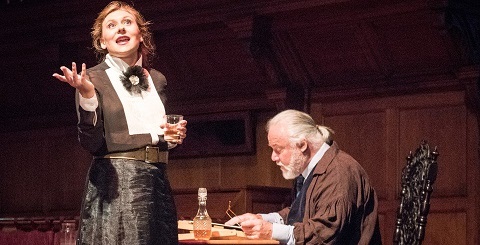 Rozanna Madylus and John Tomlinson in The Art of Love. Photo credit: Tony Nandi.
Rozanna Madylus and John Tomlinson in The Art of Love. Photo credit: Tony Nandi.
Einsamer Gang , a touchingly evocative and personal setting of a poem by Leo Greiner, expressive of Alma’s almost suicidal loneliness and depression at this period, will form part of the sequence The Art of Love: Alma Mahler’s Life and Music, which features also music by Gustav Mahler, Zemlinsky and Wagner. In the second part of these concerts, Counterpoise will perform Kokoschka’s Doll with Sir John Tomlinson, for whom it was written last year by John Casken. The painter Oskar Kokoschka had a brief but tempestuous love-affair with Alma Mahler, following which he commissioned a life-size doll of her which he took to parties and other public events. The text of this new work describes the events as seen through the eyes of Kokoschka as an older man, evoking the passions unleashed by the affair, against the background of the physical and psychological traumas suffered by Kokoschka in the First World War. The score weaves the texts into a musical fabric that references fin-de-siècle Vienna (including the music of Wagner and Alma Mahler) while being of our own time.
Kokoschka’s Doll and The Art of Love , incorporating Einsamer Gang, will be performed at:
Holywell Music Room, Oxford, Tuesday 10 April, 8.30pm
Corn Exchange, Newbury, Wednesday 16 May, 7.30pm
The press on last year’s performances of Kokoschka’s Doll : ‘Tomlinson’s titanic, heart-rending performance’ (Daily Telegraph ), ‘the incomparable John Tomlinson’, ‘a compelling dramatic presence’ ( Guardian), ‘magnificent’ (Opera), ‘riveting’ (Seen and Heard International)
For further information see:
www.counterpoise.org.uk/projects.php;
www.music.ox.ac.uk/wagner-190;
www.newburyspringfestival.org.uk
image=http://www.operatoday.com/Alma%20Maria%20Schindler%20%28Alma%20Mahler%29%2C%201899.jpg
image_description=Kokoschka’s Doll and The Art of Love: performances by Counterpoise in Oxford and Newbury
product=yes
product_title=Kokoschka’s Doll and The Art of Love: performances by Counterpoise in Oxford and Newbury
product_by=
product_id= Above: Alma Maria Schindler (Alma Mahler), 1899
Of Animals and Insects: a musical menagerie at Wigmore Hall
The programme opened with a perennial favourite, Schubert’s ‘Die Forelle’ (The trout) and Middleton and Riches immediately made evident their concern, which was sustained throughout the recital, to communicate the narrative of their chosen songs - through motivic word-painting, vocal nuance, diversity of tone and dramatic presence. Middleton delicately conjured the slithering scales and flapping tail of the capricious fish, while Riches’ strong, forth-right projection conveyed the fisherman’s determination to land his catch.
This was beautiful and vivid characterisation. And, ‘Der Alpenjäger’ (The alpine huntsman) was similarly engaging. Riches relished, here and elsewhere, the opportunity to embody different characters and their energetic debates, aiming for comic contrast between the floating appeals of a mother who wishes her son to stay at home to tend the lambs and the insistent protests of the young adventurer who yearns to set out on his quest for the gazelle. Riches’ buoyant baritone brought to mind an image of the eager hazelnut gatherer in Wordsworth’s ‘Nutting’, sallying forth ‘in the eagerness of boyish hope … Tricked out in proud disguise of cast-off weeds’! The duo exploited the way Schubert’s rhythmic structure tells the tale, culminating in the stately pronouncements of the Spirit of the Mountain who intervenes - here with a sonorous gravity worthy of Sarastro - to protect the trembling gazelle. And, alert to every expressive dimension, Riches injected a little tenderness and pathos into the god’s final plea, ‘The earth has room for all; why do you persecute my herd?’ (‘Raum für alle hat die Erde,/Was verfolgst du meine Herde?’)
Riches works hard with his texts, and - as was evident during his vibrant performance in Purcell’s King Arthur with the Academy of Ancient Music at the Barbican Hall recently - he is not afraid to prioritise textual meaning over beauty of line to deepen the expressive meaning, though there is plentiful lyrical mellifluousness too. I was impressed by the directness and impact of his diction in the three German lieder. But, while he certainly took care (perhaps too much?) with the enunciation in the sequence of late-nineteenth and early-twentieth century Gallic songs that followed, his French is less idiomatic and this did affect the vocal phrasing, as occasionally Riches’ tendency to emphasise particular syllables disrupted the evenness of the syllabic scansion that is inherent in the language and reflected in the melodic and rhythmic settings.
I think, too, that this repertory is not Riches’ natural territory; his voice is full and strong, and while he did make a good attempt to ‘lighten’ the tone, the result did not feel entirely ‘natural’. The landscape of Fauré’s ‘Le papillon et la fleur’ (The butterfly and the flower) is a world away from Schubert’s forest foraging and it took Riches a little while to settle into the new terrain, but the wry reflections of the young man troubled by the contesting attractions of his lover’s lips and the rose-coloured ladybird resting on her snow-white neck, in Saint-Saëns’ ‘La coccinelle’, were engagingly delivered, Riches swooning into romantic reverie at the parodic close. Middleton’s atmospheric accompaniment added much to the sentimental hyperbole of Massenet’ quasi-operatic ‘La mort de la cigale’ (Death of the cicada), and here Riches exercised satisfying control during the extended vocal phrases and flowed lightly through the melismas of the central section.
One wonders why the French seem to have had such a ‘thing’ for insects, for Ravel, too, included an homage to the cricket (‘Le grillon’) in his Histoires naturelle (1906). Here, Middleton’s tremulous pointillism was delicately and delightfully evocative and what was really impressive about this song was the way the duo maintained rhythmic momentum, and a beguiling narrative, despite the fragmentary vocal line and seemingly ‘static’ piano gestures. It is the birds rather than the beetles that Ravel truly celebrates though, and none more than the peacock (‘Le paon’), whose pomp and pride rang from Middleton’s introductory bars with the brightness of the feathered eyes of the bird’s train, which was itself brandished with a startling pianistic flourish at the close. Some critics have suggested that Ravel is indulging in self-portraiture, here, painting a picture of the fin de siècle artist-cum-dandy, and this performance made that reading a convincing one. I admired Riches’ memory in this song - indeed, in all of Ravel’s set of five, for the texts are lengthy and often prosaic, with subtly shifting meters. He made a good effort to make the words ‘live’ in both ‘Le martin-pêcheur’ (The kingfisher), in which Middleton’s grave tone conveyed the bird’s regal status and demeanour, and in the account, in ‘La pintade’ (The guinea-fowl), of the quarrelsome nature of a farmer’s querulous hen.
Riches’ had shown his comfort and flair in the musical theatre idiom during the LSO’s Bernstein Anniversary celebrations at the Barbican Hall, before Christmas, when he was displayed a cocksure swagger and vibrant Yankee drawl in Bernstein’s Wonderful Town. And, while this recital did not, as then, end with Riches leading the audience in a conga down Wigmore Hall’s aisles, the final item of the programme, Vernon Duke’s Ogden Nash’s Musical Zoo, did give him liberty to don his Flanders-and-Swann hat, indulge his instinct for showmanship and celebrate the piquant wit of Vernon Duke’s musical embodiments of the brief portraits which form Ogden Nash’s bestiary. I have to confess that this repertoire is not really my cup of tea (I tend to the view that the poetry isn’t worth reading, let alone setting to music, but many will, for good reasons, disagree!). But, Riches rattled off the zoological roster with panache, and his poise and pronunciation were admirable. He couldn’t resist going down to the farm one more time: his encore, ‘I Bought Me A Cat’ from Copland’s Old American Songs was a noisy and nonsensical, and fittingly ‘natural’, end to a charming recital.
This recital can be heard for one month following the performance on BBC iPlayer.
Claire Seymour
Ashley Riches (bass-baritone), Joseph Middleton (piano)
Franz Schubert - ‘Die Forelle’ D550, ‘Die Vögel’ D691, ‘Der Alpenjäger’ D588; Fauré - ‘Le papillon et la fleur’ Op.1 No.1; Saint-Saëns - ‘La coccinelle’; Massenet - ‘La mort de la cigale’; Ravel -Histoires naturelles; Vernon Duke - Ogden Nash's Musical Zoo.
Wigmore Hall, London; Monday 19th February 2018.
image=http://www.operatoday.com/ASHLEY-EDITED-HIGH-RES-15-of-37-1024x683.jpg image_description=Ashley Riches and James Middleton at Wigmore Hall product=yes product_title=Ashley Riches and James Middleton at Wigmore Hall product_by=A review by Claire Seymour product_id= Above: Ashley RichesPhoto courtesy of Askonas Holt
February 18, 2018
Hugo Wolf, Italienisches Liederbuch
Wolf, one might say, was an Austrian composer, which is or at least was certainly to say also a German composer; yet he was born in Windischgrätz, now Slovenj Gradec. Both names for what was long a Styrian town refer to the Slovene or Wendish Graz, to distinguish it from the larger Graz. And so on, and so forth. Mitteleuropaïsch is more than a collection of disparate identities; it is an identity in itself. It certainly was in the Austrian Empire in which Wolf was born, and it certainly was in the Dual Monarchy in which he grew up. Moreover, northern Italy had long been part, to varying extents, and depending on who was, of that identity too. So too, however, had a romanticised German idea of ‘Italy’, of the Mediterranean, of the South. Look to Goethe and Liszt, for instance - or to Paul Heyse’s selection and translations of songs, as set by Wolf (not greatly, or indeed at all, to Heyse’s pleasure).
What one can say is that this idealised ‘Italy’, Tuscan rispetti and Venetian vilote could only have come from without the Italian lands. If ‘German’ constitutes at least as multifarious a multitude of sins as ‘Italian’, these songs remain very much a German evocation of lightness, of sunlight, of serenades, of a ‘love’ that is rarely, if ever that of German Romanticism, although it may well be viewed through that prism. All three performers at this Barbican recital understood that, I think: both intuitively and intellectually. At any rate, the tricky balance between Italian ‘light’, in more than one sense, and German ‘prism’ seemed almost effortlessly communicated - however much art had been required to convey such an impression.
The songbook is not a song-cycle, so to speak of ‘reordering’ is perhaps slightly misleading. At any rate, the ordering selected made good sense, grouping the book’s forty-six little songs into four groups, which, if not exactly narratives of their own, made sense as scenes or, if you will, scenas. One made connections as and when one wished; nothing was forced, much as in the music and the performances themselves. Diana Damrau and Jonas Kaufmann opted, boldly yet not too boldly, for a staginess alive to the humour, or at least to the potential for humour without sending anything up or otherwise trying to turn the songs into something they are not. Helmut Deutsch, in general the straight man, perhaps had the ultimate moment of humour, in his piano evocation of a hapless violinist (‘Wie lange schon war immer mien Verlangen), Damrau having ambiguously prepared the way, at least in retrospect, with a lightly wienerisch account. Deutsch provided an excellent sense of structure throughout: non-interventionist perhaps, but none the worse for that. Damrau and Kaufmann, after all, were intended to be the ‘stars’ here.
In general, but only in general, Damrau’s performances - roughly alternating, yet with a few exceptions - were knowing, whilst Kaufmann’s were lovelorn. Such is the order of things in this ‘German Italy’. Metaphysics, when they reared their head - more in Wolf than in Heyse - tended to be the tenor’s. Was he right to make relatively little of them? I am not sure that right or wrong makes much sense here. Perhaps it is all, or mostly, in inverted commas anyway. There were a few occasions when I found Kaufmann, especially during the first half, somewhat generalised, but such generality remains a very superior form: more baritonal still than I can recall having heard him, yet with an ardent, show-stopping tenor, even upper-case Tenor, that puts one in mind, just in time, of his Walther (‘Ihr seid die Allerschönste’) or his Bacchus (‘Nicht länger kann ich singen’). And Damrau was perfectly capable of responding, of singing about his singing, as for instance, in ‘Mein Liebster singt am Haus’, to which Kaufmann’s ‘Ein Ständchen Euch zu bringen’ came as the perfect response, and so on. Piano and voice together in the latter song conveyed to near perfection the shallow yet genuine sexual impetuosity of youth. (Or is that just what older people think?) The lightness of a wastrel’s self-pity in ‘O wüsstest du, wie viel ich deinetwegen,’ was likewise finely judged. So too was the cruelty of his beloved in ‘Du denkst mit einem Fädchen’.
Yet, as the two archetypes, stereotypes, call them what you will, drew closer towards the end of the first half, there was genuine affection too, or so one thought. The rocking piano in ‘Nun lass uns Frieden schliessen’ suggested, without unnecessary underlining, a peace perhaps all the more interesting, or at least characteristic, for its lack of interest in passing all understanding. For, as that half had climaxed with an acknowledged role for Wolf’s Lisztian Romantic inheritance, so the piano harmonies of the second half took up from that half-destination, taking us somewhere new, briefly darker (the austere Doppelgänger flirtation of ‘Wir haben beide lange Zeit geschweiegen’) and ultimately, once again, ‘lighter’, yet perhaps never truly ‘light’. Sweetness of death (‘Sterb’ ich, so hüllt in Blumen meine Glieder’) intervened, yet was it but an act, the commedia dell’arte perhaps, or, as the Marschallin would soon have it, ‘eine wienerische Maskerad[e]’. Increasingly, neither party wished truly to resist, whilst making great play of doing so: on stage as well as in music. An air of Straussian sophistication became more marked, without ever shading into mere cynicism. If the ‘girl’ were always going to win, that was as it ‘should’ be. There were enough qualifications, or potential alternative paths and readings, though, to make one wonder. And then to wonder - ‘lightly’ or no - why one was wondering at all.
Mark Berry
Diana Damrau (soprano), Jonas Kaufmann (tenor), Helmut Deutsch (piano).
Barbican Hall, London; Friday 16 February 2018.
image=http://www.operatoday.com/Damrau_Kaufmann_Barrbican_1272.jpg image_description=Jonas Kaufmann and Diana Damrau perform Wolf’s Italienisches Liederbuch as part of the Barbican Presents 2017-18 season in the Barbican Hall on 16th February 2018. product=yes product_title=Jonas Kaufmann and Diana Damrau perform Wolf’s Italienisches Liederbuch as part of the Barbican Presents 2017-18 season in the Barbican Hall on 16th February 2018. product_by=A review by Mark Berry product_id= Above: Helmut Deutsch, Diana Damrau and Jonas KaufmannPhoto credit: Mark Allan/Barbican
San Jose’s Dutchman Treat
First, the company has chosen to tell the story and serve the composition, rather than impose a concept and serve themselves. It was a “first” for me to ever see real spinning wheels in the spinning scene! No kidding. I have seen, oh, let’s see, Senta in a spinning class at a fitness center, ladies spinning ship’s helms, and ladies just spinning themselves in circles. What a breath of fresh (sea) air to see such a beautifully straightforward rendering of Wagner’s intentions. That is not to say there wasn’t plenty of vibrant creativity on display.
Steven C. Kemp has designed a setting that is effectively modular, all the while framing it in a handsome fixed unit. An imposing upstage wall is flanked by angled walls stage left and right, all richly textured with planking. That wooden look, suggestive of a ship’s deck is carried over to the stage floor, this entire construction forming a sort of reflective shell that greatly enhanced the acoustic.
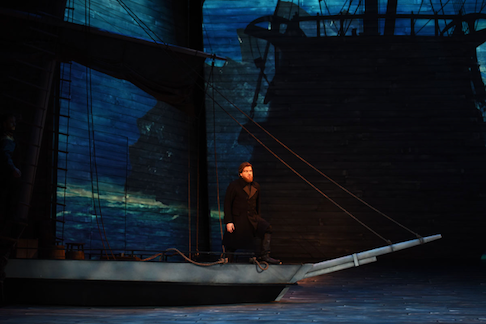 Gustav Andreassen as Daland
Gustav Andreassen as Daland
Walls can fly and retract, allowing for the addition of other scenic elements: the upstage row of windows in the spinning room, Daland’s merchant ship down right, rustic tables and benches for the revelry in the final scene. That this simplicity worked so well owes a great debt to the sumptuous, variegated lighting design by David Lee Cuthbert and especially the superlative projection design by Ian Wallace.
Wagner often envisioned stage effects without workable ideas to execute them, and in this case a spectral ship with ghostly, singing passengers must appear on cue; Senta must sacrifice her life with a suicidal leap into the roiling sea; and the Dutchman’s redemption must be visualized. It is to this talented team’s credit, that all of these challenges were persuasively met with uncommonly apt choices. If Wagner had know technical possibilities like this could be achieved, he would have undoubtedly come up with even more brainstorms!
Johann Stegmeir has provided a splendid array of costumes that were homey, comfortable, and definitive of their character’s stations in life. The pleasing silhouette of Senta’s lovely gown was matched by the effectiveness of its rich blue sheen. The folk nature of the chorus attire allowed Mr. Steigmeier to indulge in some careful use of color. Conversely, he applied more austerity to the Dutchman’s look, managing to make him look mysteriously appealing, without becoming grotesquely sinister. As always Christina Martin’s wig and make-up design was so “right” that we almost take it for granted.
Joseph Marcheso drew wondrous playing from his orchestra, with the banks of strings luxuriating in the lush writing. The winds were similarly characterful and stylistically secure. The brass provided exciting accents, with the horns nailing the familiar opening statement of the overture. Maestro Marcheso paced the evening with skill and obvious enjoyment and he drew impressive results that the most celebrated houses would take pride in. He also proved to be a highly capable partner with a cadre of exciting vocalists.
If this performance is any evidence, bass-baritone Noah Bouley is a rising star that seems poised to become the next Dutchman “of choice.” There is nothing about the taxing role that eludes him. Mr. Bouley has a robust, rolling tone that is well-supported and responsive to his every interpretive nuance. His rich vocalizing and well-considered musical journey resulted in a potent, cathartic performance.
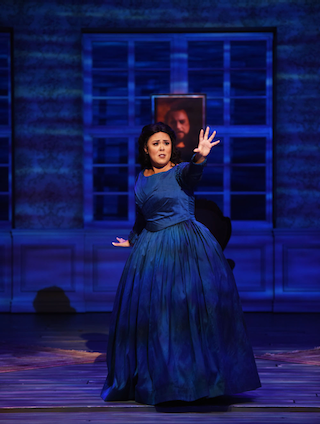 Kerriann Otaño as Senta
Kerriann Otaño as Senta
Kerriann Otaño’s engaging, rich soprano has the heft and beauty that makes hers a memorable Senta. Just listen to the variety of color she brings to her opening aria, and revel in its specificity and pliability. Ms. Otaño has the technique and musical intelligence to not only limn the introspective moments with ravishing beauty, but also ride the amassed orchestra with thrilling focus and power.
Gustav Andreassen brings a meaty, buzzy bass-baritone to the role of Daland. He is more youthful then some interpreters of this paternal role, but the sheer power of his utterance and the mellifluous tonal production fell gratefully on the ear. Derek Taylor was a splendid Erik, his steely, substantial tenor filling the house with poised phrasings.
Fresh-voiced Mason Gates successfully brought his well-schooled tenor and youthful exuberance to the role of the Steersman, and he made the most of his featured solos. The role of Mary is often doled out to veteran singers in their twilight years (Astrid Varnay, anyone?). Not so in San Jose. Nicole Birkland was easily the most impressive Mary I have yet heard, her prime, plummy mezzo filling the California Theatre with warm, expressive sound. Andrew Whitfield’s precise, robust chorus covered themselves in glory, easily giving the best performance I have ever heard from this talented ensemble.
In another first for me, San Jose performed the work in three acts, rather than the usual one long act that has been my experience. Well, sort of. While the first act had a proper intermission, and while the act curtain rang down after act two, the last two acts did nonetheless utilize the musical bridge that connects the last two thirds of the piece.
All that being said, there is no denying that Opera San Jose has presented a Flying Dutchman of such accomplishment that it could put itself firmly on the map for Wagner enthusiasts. Wunderbar!
James Sohre
Cast and production information:
Steersman: Mason Gates; Daland: Gustav Andreassen; The Dutchman: Noel Bouley; Senta: Kerriann Otaño; Mary: Nicole Birkland; Erik: Derek Taylor; Conductor: Joseph Marcheso; Director: Brad Dalton; Set Design: Steven C. Kemp; Costume Design: Johann Stegmeir; Lighting Design: David Lee Cuthbert; Projection Design: Ian Wallace; Wig and Make-up Design: Christina Martin; Chorus Master: Andrew Whitfield
image=http://www.operatoday.com/Dutchman_SanJose2.png
product=yes
product_title=San Jose Dutchman Treat
product_by=A review by James Sohre
product_id=Above: Noel Bouley as the Dutchman [All photos copyright Pat Kirk, courtesy of Opera San Jose].
February 16, 2018
Mortal Voices: the Academy of Ancient Music at Milton Court
On the one hand, a musician’s survival depended on patronage: wealthy individuals, and the institutes of state and Church, put their hands in their pockets and enabled budding young composers to learn their craft, and geniuses to get on with the business of composing masterpieces. On the other, the reflected glory - reputation for cultural discernment and refinement, social status among the wealthy elite - derived from works composed on demand was worth paying for.
Handel arrived in Rome in 1707 and one of his patrons was Cardinal Pietro Ottoboni who, each Wednesday, held concerts in his Palazzo della Cancelleria, directed by Corelli. Some think that Handel’s solo cantata, ‘Ah! che troppo ineguali’, may have been commissioned by Ottoboni; others that the commission came in 1708 from Cardinal Colonna, in celebration of the feast of the Madonna del Carmine. Whatever and whoever, the Church clearly had a hand in the composition: the text is religious, but non-liturgical, the brief recitative and short aria comprising a supplication to the Queen of Heaven to send peace down to earth - most likely a response to the War of the Austrian Succession in which the Papal States were then engaged.
Canadian soprano Keri Fuge, who won second prize in the 2011 Handel Singing Competition, seemed a little tense during the recitative, and took a while to gage the dimensions of the Milton Court Concert Hall. But, the slight shrillness and over-emphatic accents had gone by the time Fuge reached the da capo repeat, and though she employed what I thought was a rather wide vibrato, she summoned a noble eloquence which matched the sentiments of the accompaniment provided by members of the Academy of Ancient Music, directed by Christian Curnyn who made much of the expressive contrast between the high shine of the violins and the low sonorous of the bass strings and organ.
Fuge was joined by countertenor Tim Mead for Handel’s duet-cantata ‘Il Duello Amoroso’, which was composed in 1708 for Marquis Francesco Maria Ruspoli, a member of the Arcadian Academy. It presents a stand-off between a love-sick Arcadian shepherd, Daliso, and the scornful and supercilious Amarilli. Handel’s setting is characteristically playful: when Daliso threatens to subdue the teasing nymph, ‘either by force or inclination or resentment before the enticing pains of death come’, Amarilli doesn’t bat an eyelid: ‘No more! I would have you satisfy the wicked desire that torments you; unfeeling man, come! Why delay? Take the blade and strike it into this heart.’ The humiliated Daliso retreats and demands that she return his heart only to be further emasculated: ‘you do not have the torch that can kindle my flame.’
 Keri Fuge.
Keri Fuge.
The menuetto of the three-part overture was delicately wry, but Mead initially seemed quietly crestfallen even stoical, rather than indignant and resentful, about his rejection. That said, his countertenor was agile and light, then sensuously legato, in the two parts of his opening aria, and later he summoned a simple plaintiveness - ‘Is it better to hear many times promises of love but not when they may be fulfilled?’ - which was complemented by some finely phrased violin-playing from the AAM. Fuge was more ‘on score’ and this, as well as Mead’s tendency to prioritise mellifluous beauty over dramatic impact, did temper the dramatic frisson between the pair. But, Amarilli’s cruelty was evident in a slight edge to the voice and in the pointed echoes between soprano and violins, though as the temptress’s fury rose so Fuge’s focus and intonation became less consistent. The showdown was spirited with Mead summoning an angry pride, expressed through vivid adornment - ‘Sì, sì, lasciami ingrate’ (Very well, leave me alone, heartless girl) - his bitterness highlighted by the contrast between the high vocal line and low-pitched accompaniment of cellos, bass and continuo.
Pergolesi’s Stabat Mater - commissioned by the Brotherhood of the Vergine dei dolori in Naples, in 1736 - followed after the interval, with the original vocal ensemble reduced to just two voices. I’m not sure of the wisdom of this slimming down of the vocal sound: in the opening duet, the poignant suspensions did not register as emphatically or with the immediacy that one might expect. Moreover, despite their concerted efforts to blend their voices, particularly in the duet ‘Sancta mater, istud agas’ (Holy mother, pierce me through), Fuge’s soprano was often dominant.
That said, the soprano aria ‘Vidit suum dulcem natum’ (She beheld her gentle child) which lies lower in the voice was very affecting, unfolding quietly and lyrically above hesitant accompanying phrases. And, the fugal duet, ‘Fac ut ardeat cor meum’ (Make me feel as thou has felt), generated fervency and passion.
Mead’s aria, ‘Fac ut portem Christi mortem’ was beautifully sung and his strong technique - well-crafted phrasing, assured breath control, impressive trills - apparent; the orchestral unisons added rhetorical weight.
In the final duet, ‘Quando corpus morietur’ (While my body here decays), the violas and celli shuddered with a suffering that was more tender than tragic. One was reminded of the question asked by Jean Frangois Marmontel in the Mercure de France (September 1778): ‘Does it not cause tears to fall?’ And as the vocal lines wound around each other the resultant dissonances made for a delicate but affecting statement of anguish and faith.
In this concert, The Academy of Ancient Music confirmed their status as perhaps the finest period-instrument ensemble performing today, not least with the fleet-footed performance of Corelli’s Concerto Grosso Op.6 No.1 in D major that opened the programme. The antiphonal placement of the violins created drama and excitement - there was some wonderfully seamless interplay between both section-leaders, Bojan Čičić and Rebecca Livermore, and the full violin ranks, particularly in the second Allegro. And, Curnyn drew a warm, full sound from his fairly small ensemble, Alastair Ross’s organ providing sonorous depth, particularly in the slow movements. The upper string players were standing throughout the concert which encouraged vitality and freedom - lead viola Alexandru-Mihai Bota exhibited surprising balletic nimbleness, despite his height! - but it was a pity that cellist Joseph Crouch was rather ‘buried’ amid the ensemble, for his contributions to the concertante episodes were beautifully dulcet yet incisive. The facility of all conveyed a virtuosic ease which, at the final cadence, cohered into a closing gesture of graciousness and taste.
Claire Seymour
Keri Fuge (soprano), Tim Mead (counter-tenor), Christian Curnyn (director, harpsichord), Academy of Ancient Music.
Corelli - Concerto Grosso Op.6 No.1 in D major, Handel - Cantatas HWV230 ‘Ah! Che troppo ineguali’ and HWV82 ‘Il Duello Amoroso’, Pergolesi - Stabat Mater.
Milton Court, London; Thursday 15th February 2018.
image=http://www.operatoday.com/Tim%2BMead_May%2B2013_166bw_%28c%29%2BBenjamin%2BEalovega.jpg image_description=Mortal VoicesAcademy of Ancient Music at Milton Court Concert Hall product=yes product_title=Mortal VoicesAcademy of Ancient Music at Milton Court Concert Hall product_by=A review by Claire Seymour product_id= Above: Tim MeadPhoto credit: Benjamin Ealovega
Glyndebourne Opera Cup 2018: semi-finalists announced
The singers will be competing for one of 10 places in the final on 24 March, which will be broadcast live on Sky Arts. The overall winner will receive £15,000 and the guarantee of a role within five years at one of the top opera houses represented on the competition jury.
Fourteen nationalities are represented among the semi-finalists, reflecting the international scope of the competition. The countries represented are Austria, Canada, Estonia, Finland, France, Germany, Guatemala, Ireland, Kosovo, Mexico, Poland, the UK, Ukraine, and the USA.
The backgrounds of the semi-finalists are as varied as their nationalities. Among them are soprano Elbenita Kajtazi (26), who as a young girl was forced to flee her home in war-torn Kosovo with her family, and live as a refugee in Albania. She fell in love with opera after watching clips of Maria Callas on YouTube. Soprano Francesca Chiejina (27), born in Lagos, Nigeria, had first planned to be a doctor before she caught the singing bug, as had her fellow semi-finalist, Canadian tenor Charles Sy (26). American bass baritone Cody Quattlebaum (24) was a chef for six years before he decided to commit to his musical career. Further details about the contestants will be revealed in an hour-long Glyndebourne Opera Cup documentary to be broadcast on Sky Arts on Thursday 22 March.
The Glyndebourne Opera Cup focuses on a different single composer or strand of the repertoire. In 2018 the featured composer is Mozart and the Orchestra of the Age of Enlightenment will accompany the singers at the final.
The full list of semi-finalists is:
Adèle Charvet
24, mezzo-soprano (France)
Francesca Chiejina
27, soprano (USA)
Jorge Espino
26, baritone (Mexico)
Adriana Gonzalez
26, soprano (Guatemala)
Samantha Hankey
24, mezzo-soprano (USA)
Elbenita Kajtazi
26, soprano (Kosovo)
Dmytro Kalmuchyn
24, baritone (Ukraine)
Aurora Marthens
25, soprano (Finland)
Mirjam Mesak
27, soprano (Estonia)
Denis Milo
27, baritone (Germany)
Jake Muffett
24, baritone (UK)
Diana Newman
28, soprano (USA)
Gemma Ní Bhriain
25, mezzo-soprano (Ireland)
Alexandra Nowakowski
25, soprano (USA/Poland)
Eléonore Pancrazi
27, mezzo-soprano (France)
Emily Pogorelc
21, soprano (USA)
Cody Quattlebaum
24, bass-baritone (USA)
Anita Rosati
24, soprano (Austria)
Carl Rumstadt
25, baritone (Germany)
Jacquelyn Stucker 28, soprano (USA)
Jack Swanson
24, tenor (USA)
Charles Sy
26, tenor (Canada)
Hubert Zapiór
23, baritone (Poland)
A further heat will take place nearer the semi-final for a small number of contestants who had qualified for the competition but for reasons of illness were unable to attend one of the preliminary rounds, so it is possible that one or two additional names will be added to the list at a later date.
‘Glyndebourne enjoys a long held reputation for finding and nurturing new talent,’ says Gus Christie, Glyndebourne’s Executive Chairman. ‘It is with this in mind that I look forward to welcoming all of the competitors to the inaugural Glyndebourne Opera Cup semi-final on 22 March.
‘These talented young singers will have the opportunity to perform on the Glyndebourne stage, sing in front of a TV audience and ultimately have the chance of winning a cash prize and even a major operatic role. I wish them all the very best of luck and am delighted that Glyndebourne is able to showcase this new generation of singers on our stage.’
Sebastian F. Schwarz, Chair of The Glyndebourne Opera Cup jury, says, ‘These young singers piqued our curiosity; they revealed engaging artistic personalities and promising, beautiful instruments, and they demonstrated superior technical and musical skills.’
‘I am delighted with the semi-finalists we have chosen,’ adds Schwarz. ‘They represent the best Mozart singing to be found in their age group (up to 28) and reaffirm my hopes about the future of opera. I am very excited to be hearing them all again in the semi-final at Glyndebourne and wish each of them the very best.’
The international jury for The Glyndebourne Opera Cup includes representatives from top international opera houses. Among them are Barrie Kosky, Artistic Director of Komische Oper Berlin, Sophie de Lint, Artistic Director of Zurich Opera and Director Designate of Dutch National Opera, David Devan, who runs Opera Philadelphia, Fortunato Ortombina, Sovrintendente of Teatro La Fenice in Venice, and Joan Matabosch, Artistic Director of Teatro Real in Madrid.
Acting as the competition’s honorary president is Dame Janet Baker, whose own early career was fostered by Glyndebourne. As well as presenting the prizes, she will adjudicate at the live final.
The semi-finals and final of the Glyndebourne Opera Cup take place on the 22 and 24 March respectively at Glyndebourne, Lewes, East Sussex, BN8 5UU. For tickets please go to glyndebourne.com . The final is currently sold out, please call 01273 815 000 for returns.
The highlights of the Glyndebourne Opera Cup worldwide heats will air on the 22 March, with the semi-final on the 23rd March and the live final on the 24 March, on Sky Arts.
image=http://www.operatoday.com/Glyndebourne%20Cup.gif image_description=Glyndebourne Cup, 2018 product=yes product_title=Glyndebourne Cup, 2018 product_by= product_id=ENO announces Studio Live casts and three new Harewood Artists
Acis and Galatea will take place at ENO’s historic rehearsal studios, Lilian Baylis House. Paul Bunyan will be ENO’s first collaboration with Wilton’s Music Hall. Both pieces are being performed by ENO for the very first time and celebrate the integral roles that Handel and Britten have played in the company’s history.
In addition, ENO have announced that three exceptional young singers Rowan Pierce, Alex Otterburn and William Morgan will become ENO Harewood Artists with immediate effect. The ENO Harewood Artist programme was established in 1998 as a means of providing a full-time training and performance scheme for exceptionally talented singers at the beginning of their careers. They will join current ENO Harewood Artists Andri Björn Róbertsson, Katie Coventry, Eleanor Dennis, Matthew Durkan, David Ireland, Rhian Lois, Elgan Llyr Thomas, Soraya Mafi, Samantha Price, Božidar Smiljanić, Katie Stevenson and David Webb.
Acis and Galatea (six performances, 9-16 June 2018, Lilian Baylis House)
Directed by Sarah Tipple, designed by Justin Nardella and conducted by Nicholas Ansdell Evans, Acis and Galatea features four exciting young British singers. Tenor Alexander Sprague and soprano Lucy Hall sing the title roles. ENO Harewood Artist Matthew Durkan sings the role of Polyphemus and Bradley Smith makes his ENO debut as Damon.
Paul Bunyan (six performances, 3-8 September, Wilton’s Music Hall)
Directed by Jamie Manton, designed by Camilla Clarke and conducted by Matthew Kofi Waldren, Paul Bunyan will be a celebration of ENO’s exceptional emerging and in-house talent. Roles will be sung by ENO Harewood Artists (Elgan Llyr Thomas, Rowan Pierce, William Morgan) and members of ENO’s award-winning Chorus.
image=http://www.operatoday.com/William%20Morgan%20%28c%29%20Simon%20Goldsmith.jpg
image_description=ENO Studio Live 2018; Harwood Artists
product=yes
product_title=ENO Studio Live 2018; Harwood Artists
product_by=
product_id=Above: William Morgan
Photo credit: Simon Goldsmith
Handel in London: 2018 London Handel Festival
Samir Savant, Festival Director of the London Handel Festival, today announced the programme for its 2018 Festival which takes “Handel in London” as its theme - a four-week celebration of the life and work of Handel, in particular his life as a European who settled in Georgian London, entrepreneur and philanthropist.
This year, the Festival explores Handel’s particular relationship with the capital, his broad and varied musical output in the city he chose to settle in and his broader life in Georgian society. In addition to all the concerts planned, this year’s Festival expands the range of events on offer and presents walks, talks and a film screening focusing on many aspects of Handel’s life beyond his music, such as his expertise in investing and his relationship with health and medicine.
While continuing to present concerts at Handel’s parish church, St George’s, Hanover Square, the Festival expands with events at Wigmore Hall, Foundling Museum, Handel & Hendrix in London, the Charterhouse, as well as St Lawrence's Church, Little Stanmore. The stunning Grade II listed Fitzrovia Hospital Chapel is a new venue for the Festival.
The Festival continues in its ambition to nurture young talent and explore lesser-known repertoire. The internationally acclaimed Handel Singing Competition is in its 16th year, and this year’s Festival features no fewer than 20 past finalists as soloists on various dates.
Samir Savant, Festival Director, said “ I am delighted to present ‘Handel in London’ - our 2018 London Handel Festival. We are packing more than ever into just one month with a wonderful array of performances, ranging from grand opera to intimate chamber recitals, in addition to special walks and talks to highlight Handel’s special relationship with Georgian London. Handel has a valuable message for us today - he was a European immigrant who chose London as his home, and, quite apart from his glorious music, his cosmopolitan tastes and unstoppable commercial energy, and his professed love of his adopted society through his philanthropy, resonate still in our diverse and vibrant capital city .”
Laurence Cummings continues his role as Musical Director of the London Handel Festival. As one of the world’s leading conductors, he has an encyclopaedic knowledge of the repertoire, which, combined with his dedication to nurturing young singers, ensures that the Festival remains as distinctive and engaging as ever.
The 2018 London Handel Festival opens with the Foundling Hospital Anthem, written by Handel to raise money for the orphan “foundlings” abandoned on the streets of Georgian London (18 March).
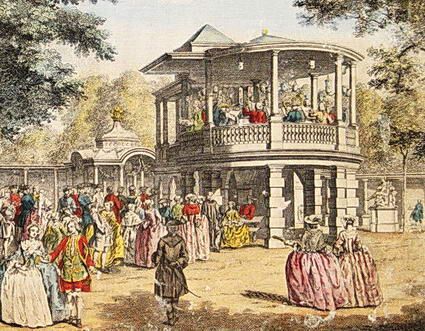 Grand Walk, 1751.
Grand Walk, 1751.
The 2018 London Handel Festival celebrates the 300th anniversary of the very first performance of Acis and Galatea, with a colourful staging of Handel’s popular pastoral opera, taken from Ovid’s Metamorphoses (19 & 21 March).
Amadigi di Gaula , a Good and Evil tale of love, jealousy, betrayal and sorcery, is performed by 2017 Handel Singing Competition winner Maria Ostroukhova and features Michal Czerniawski, Erica Eloff and Ilona Revolskaya (24 March).
Other highlights of this year’s festival include Giulio Cesare, performed by Tim Mead and Anna Devin in the lead roles. Early Opera Company makes its London Handel Festival debut under the baton of Christian Curnyn (11 April).La Nuova Musica, conducted by David Bates will present Teseo, an intriguing work written in five acts in the French tradition, featuring young singers from Royal Academy Opera (12 and 14 April).
2018 marks the 16th anniversary of the Handel Singing Competition which has given now established artists and past finalists such asIestyn Davies, Ruby Hughes and Lucy Crowe valuable exposure and recognition. The London Handel Festival has always had the nurturing of young talent at the centre of its artistic policy and a 2017 Finalists Recital at the Fitzrovia Hospital Chapel (20 March) and ‘Mr Handel’s Scholars’ concert with Laurence Cummings and the London Handel Orchestra (23 March) will celebrate the Competition’s legacy. The Semi-Final and Final of the 2018 Handel Singing Competition will take place on 28 March and 10 April .
Alongside all its innovations, the 2018 edition of the London Handel Festival will present its well-loved landmarks. The annual sell-out performance of Bach's St Matthew Passion on Good Friday returns with previous competition finalists George Humphreys and Nathan Vale, and the annual visit to Wigmore Hall will see Adrian Butterfield direct Esther (22 March, returns only).
A special performance of Handel’s Water Music, directed by Walter Reiter, performed for schools by students from Trinity Laban Conservatoire for Music & Dance is designed to encourage children to gain an understanding of Handel and his life and works (29 March).
Public booking opened on 30th January 2018. Book tickets
here
http://www.london-handel-festival.com/
Dartington International Summer School & Festival: 70th anniversary programme
Dartington Hall is a Grade1 listed country estate located in Totnes, Devon. The estate was built in the 14th century but founded as a centre for culture and creativity by Dorothy and Leonard Elmhirst in 1925. The International Summer School moved to Dartington in 1953, following its founding by William Glock in 1948 at Bryanston School in Dorset.
The Summer School & Festival is well known for its extraordinary courses, providing a unique and immersive experience for musicians of all levels of learning, talent and skill. It is renowned for offering amateurs, students and young professionals a unique opportunity to play with the world’s leading musicians - and offers the space to established artists to experiment, and explore new collaborations.
Professor Joanna MacGregor OBE is Artistic Director of the Summer School & Festival and is a British concert pianist, conductor and composer. As well as directing the artistic programme for the festival, she is Head of Piano at the Royal Academy of Music, Professor of the University of London and holds an honorary doctorate from the University of Cambridge. She was previously artistic director of the Bath International Music Festival from 2006 to 2012 and in 2015 was appointed Artistic Director of the Dartington International Summer School & Festival.
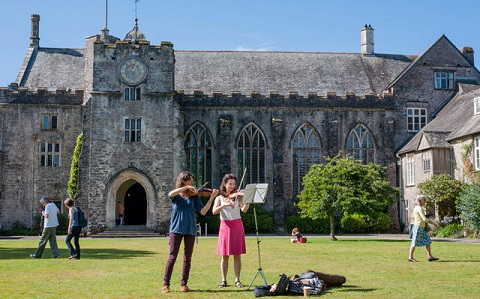
MacGregor has invited prominent names from the classical music world, and luminaries from other genres, from jazz to folk, and the wider arts, in an outstanding four-week programme of masterclasses, workshops and performance. Highlights include Alfred Brendel, Ex Cathedra, Imogen Cooper, Jane Glover, Tom Randle, Freya Waley-Cohen, Adrian Brendel and Oliver Knussen, who will teach courses and perform alongside coaching, premieres, new collaborations and a carefully curated selection of non-musical events including, poetry readings, films, art installations and yoga. Choral projects include Bolivian Masses, Bach’s St Matthew Passion, Haydn’s Creation and Verdi’s Requiem. Byron Wallen will present an exclusive jazz project, that honours Martin Luther King and the Harlem Renaissance. Latin American music will be celebrated Adriano Adewale and Luiz Morais and a special flamenco performance will take place.
Opera highlights include Felicity Lott and Mark Austin teaching an Advanced Opera Course, a performance of Mozart’s The Marriage of Figaro and vocal masterclasses from Clare Wilkinson, Nicholas Clapton and Sarah Gabriel.
Dartington offers a bursary scheme to help students, graduates and young musicians attend advanced courses. Bursary applications will be accepted from December 2017 and applied for via www.dartington.org/summer-school.
image=http://www.operatoday.com/Dartington.jpg image_description=Dartington International Summer School & Festival product=yes product_title= Dartington International Summer School & Festival product_by= product_id= Above: Dartington HallFebruary 14, 2018
I Puritani at Lyric Opera of Chicago
The protagonists Elvira Walton and Lord Arturo Talbot are sung by Albina Shagimuratova and Lawrence Brownlee. Sir Riccardo Forth, rival of Arturo for the affections of Elvira, is portrayed by Anthony Clark Evans, Sir Giorgio Walton, uncle and protector of Elvira, by Adrian Sâmpetrean. The roles of Queen Enrichetta, Sir Bruno Robertson, and Lord Gualtiero Walton are sung by Lauren Decker, Alec Carlson, and Alan Higgs respectively. The Lyric Opera Orchestra is conducted by Enrique Mazzola and the Lyric Opera Chorus is prepared by Chorus Master Michael Black. This production is owned by the Metropolitan Opera, New York with original sets and costumes by Ming Cho Lee and the late Peter J. Hall. The current revival is directed by Eric Einhorn, with lighting by Chris Maravich and wigs and makeup by Sarah Hatten.
During the three scenes of Act One vocal numbers are distributed evenly among the principal singers, predominant conflicts are drawn, and the inevitable crisis is reached by the end of the act. Additionally, the chorus is established as public witness to and commentary on the action. During the brief orchestral prelude, led with brisk tempos by Mr. Mazzola, a painted scrim suggests a tranquil, natural scene; when lifted, the exterior of a collective fortress and church become the immediate focus of the stage. Ming Cho Lee’s realistic sets effectively shift the peaceful depiction of nature into the observable distance. At daybreak the chorus representing a change of guard led by Sir Bruno declares “All’erta!” (“Awake!”). Morning hymns sung by the principals are audible from within the church. The chorus, outfitted in a mix of armor and Cromwellian garb, assembles in formation after the sound of a snare drum. Bound with other political prisoners by a rope indicating captivity, the former Queen Enrichetta is led across the stage. As Mr. Carlson’s Bruno directs the spirits of the chorus “A festa!’ (“Rejoice!”), the assembly departs the stage. The balance of the first scene is devoted to Riccardo who enters in a state of dejection. In this role Mr. Clark Evans captures the mood of a dispirited suitor for he has just learned that his beloved Elvira has been promised unexpectedly in marriage to Arturo. In confessing his emotions to Sir Bruno, the declamation used by Clark Evans incorporates lyrical phrasing heard to full extent in the following aria. As a response to the sound of Elvira’s voice he can still utter her name with touching legato while conversely describing the “amari pianti” (“bitter tears”) which he cannot help but feel in his heart. In the first part of his subsequent aria Clark Evans kneels while he muses on the “fior d’amore” (“flower of love”), a phrase which he decorates excitedly before giving “la vita” (“life”) a distinctive, somber color. His previous hope “del tuo amor” (“of your love”) is sung with lingering rubato as a convincing memory. These latter thoughts predominate in the second, more rapid part of Riccardo’s solo, sung while Sir Bruno prods him to take solace in military life. Clark Evans sings “Bel sogno beato” with lyrical ardor while ending this memory and scene with polished runs on “tenero” and a dramatic top note in the line “d’un tenero amor.”
At the start of the second scene the scrim rises to show a spare interior with Giogio seated at a table and Elvira caught in nervous movement. Costumes reveal the noble standing of this uncle and niece, while Elvira speaks here of “mio secondo padre” (“my second father”). This closeness indeed allows Giorgio to communicate the news of her impending wedding. Mr. Sâmpetrean’s rich, bass voice envelops ideally the role of Elvira’s adviser. His expressive face and gestures communicate here and in later scenes the position of guiding authority. When Sâmpetrean imparts his tidings with the emphatic line, “Oggi sposa sarai” (“Today you will be a bride”), his voice rises naturally in both pitch and volume to conclude with the mood of joy. In Elvira’s initial response to the announcement Shagimuratova shows the character’s implicit misunderstanding in the words “Strascinata - un dì sarò” (“If I am forced one day”), while the vocal line is performed here with cautious correctness. Once Elvira realizes that she is to marry her true beloved Arturo, both characters sing in unified celebration. When Giorgio’s impatience with the maiden recedes, his solo description of advice given to Lord Walton is expressed by Sâmpetrean in rounded, vibrant lines concluding with striking decoration on “la figlia misera” (“the wretched daughter”). The scene concludes with the rapid duet “A quel suono, al nome amato” (“At the sound of the beloved’s name”) and Shagimuratova’s squarely-placed top note to signal her happy state.
The third and longest scene of the act introduces onto the stage the character Arturo, who is greeted along with Elvira by the chorus of squires and maidens. This scene exemplifies Mr. Brownlee’s superlative performance, which seems to become even more fervent during the course of the opera. Simply put, Brownlee’s tenor voice has the gift of projecting and varying Bellini’s vocal line with a beauty and intensity that defies comparison. In his initial “A te, o cara” (“To you, beloved”) the voice undulates while singing embellishments on the formulation “in pianto” (“weeping”) experienced earlier as a sign of love. Brownlee’s expression rises with gradual intensity on “esultar” (“exultation”), yet also with sudden emotion on the past “tormento” now recalled. A concluding high note decorating “m’è più caro” (“but even more dear”) summarizes the character’s ultimate sense of joy at this moment. In the ensemble with Giorgio, Elvira, Walton and the chorus Brownlee’s emphatic appeal “Benedici” (“Bless”) traces a distinct line guiding the hope for happiness. At this juncture of unquestioned “gioia” Arturo becomes distracted at the sight of the captive noblewoman. When the others leave to prepare Elvira for the ceremony, Arturo learns that he is in the presence of the deposed queen. Since his own father had died for the Stuart cause, Arturo is determined to save Enrichetta. The dialogue between Ms. Decker’s moving Enrichetta and Arturo intensifies with Brownlee’s spirited assurances of help even at the expense of his own life. The return of an innocent Elvira in partial bridal array not only interrupts the plan of rescue yet will also provide a means to carry it out. Shagimuratova’s performance of “Son vergin vezzosa” (“I’m a pretty maiden”) enhances her character’s unsuspecting trust in the power of love. Here the voice moves fluidly throughout the skipping lines with Shagimuratova singing well-chosen variations in the repeat. Elvira’s suggestion that Enrichetta try on the bridal veil becomes, of course, Arturo’s idea for disguising the queen. The heroine’s departure from the scene to complete her bridal attire leaves Arturo again alone with the queen. Brownlee’s impulsive movements and dramatically impassioned cry “Vieni … per pietà” (“Come … do come”) place the fleeing pair squarely in the path of Riccardo. Since the latter has returned to challenge Arturo to a duel, their subsequent exchange provides an opportunity for heightened, vocal display. As an illustration of his character’s anger and excitement Clark Evans sings with a series of rapid runs the line “Qui ti sfido a mortal guerra” (“I hereby challenge you to a duel”). In response, Brownlee punctuates “Sprezzo … il tuo furore” (“I scorn your fury”) with comparable embellishment and concludes with a series of ascending, high pitches. The subsequent duel is credibly staged and stopped only when Enrichetta intervenes to prevent bloodshed. At the revelation of the queen’s identity, Riccardo encourages her escape with Arturo and the damning political association this will cause. The return of the wedding guests allows Riccardo to point to Arturo’s presumed treachery. In the concluding ensemble Shagimuratova delineates Elvira’s dismay with a secure line traced through swelling orchestral variation. Her emotional state is enhanced here with touches of vibrato and a final trill before collapsing in the presence of the shocked assembly.
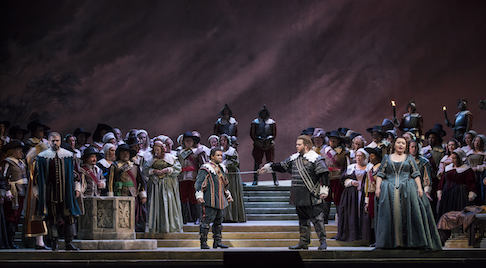 Adrian Sâmpetrean, Lawrence Brownlee, Anthony Clark Evans, Albina Shagimuratova [Photo © Todd Rosenberg]
Adrian Sâmpetrean, Lawrence Brownlee, Anthony Clark Evans, Albina Shagimuratova [Photo © Todd Rosenberg]
Act Two of I puritani is bookended by male voices reflecting on and reacting to Elvira’s condition and its consequences. At first, the chorus of sympathizers solicits tidings of Elvira from Giorgio until he describes her present instability. In his aria, “Cinta di fiori” (“Decked with flowers”) Sâmpetrean presents with resonant legato a sympathetic image of the girl’s volatile mind. His emphasis on “chiede all’aura” (“she asks the air”) has the effect of a heartfelt wince. Both he and Riccardo become witness to Elvira’s distracted spirit when she enters and sings “Qui la voce sua soave” (“Here his gentle voice”). In this showpiece aria Shagimuratova traces limpid streams of vocal color to combine the disjointed memories of past hope with imminent delusion. In the rapid segment of the aria she incorporates individual decorative and dramatic gestures, illustrating to both men her delirium. Once she departs, it is left to Giorgio to convince Riccardo to reverse his feelings of resentment. Sâmpetrean leads this exciting exchange with fervent, repeated appeals on “il rival salvar” (“save your rival”) and extended declarations to “Riccardo.” The final duet “Suoni la tromba” (“Let the trumpet sound”) shows the success of Giorgio’s wisdom with heroic conviction from both singers on “Libertà!”
At the start of Act Three the exiled Arturo has returned secretly to his homeland. In order to simulate the wide-ranging danger of his position, this production uses the side-aisles of the theater for approach or departure of soldiers and principal. After his moving exclamations of “O patria! O amore!” Brownlee details with equal fervor “Com’ è dolce” (“how sweet is”) the moment of return after months of exile. When he hears from offstage Elvira singing “La mia canzon d’amor” that he used to sing to his beloved, he begs to see her yet receives no response. Sunk in further reflection, Brownlee relates his “esilio, odi il mio pianto” (“my exile and my tears”) with an effective, saddening diminuendo. He repeats the very melody just sung by Elvira, now with the words “Corre a valle, corre a monte” (“He hastens to valley, to mountain”). This rejoinder by means of the love-song indeed rekindles Elvira’s sanity and unites both momentarily in their previous affection. The identification of the unknown woman as queen finally dispels Elvira’s doubts. In their duet starting “Vieni fra queste braccia” (“Come to my arms”) Brownlee and Shagimuratova deliver excited top notes in their unified exhilaration.
Yet this happiness requires a further vocal development. At Riccardo’s declaration of Arturo’s capture and imminent execution, Elvira’s fragile state fades once again into distraction. Before the political resolution yielding a general pardon to all those guilty, Arturo accuses his opponents of cruelty toward Elvira. In the scene beginning “Creadisi, misera!” (“The poor girl believed”) Arturo delivers his final appeal to spare Elvira’s sanity and life. Brownlee sings “Crudeli!” (“Cruel men!”) with a dramatic force demanding attention. When he warns with emotional top notes “Ella è tremante, ella è spirante” (“She is trembling, she is dying”), he has surely moved the crowd to sympathy. In the repeat of his admonition, Brownlee sings “Un solo istante, Ah! L’ira frenate!” (“For a single moment, cease your wrath!”) with Bellini’s challenging, higher pitches bringing listeners to gasping tears. Once the pardon is announced at the sound of a hunting horn, sanity and love are restored. The final cabaletta for soprano is included in this production. Shagimuratova embellishes this aria with spirit and freedom, in the conclusion of a performance that ranks among today’s great tributes to nineteenth-century opera.
Salvatore Calomino
image=http://www.operatoday.com/Albina%20Shagimuratova_Adrian%20Sa%CC%82mpetrean_Lawrence%20Brownlee_I%20PURITANI_CU-113_c.Andrew%20Cioffi.png
image_description=Albina Shagimuratova, Adrian Sâmpetrean, and Lawrence Brownlee [Photo © Andrew Cioffi]
product=yes
product_title=I Puritani at Lyric Opera of Chicago
product_by=A review by Salvatore Calomino
product_id=Above: Albina Shagimuratova, Adrian Sâmpetrean, and Lawrence Brownlee [Photo © Andrew Cioffi]
Iolanthe: English National Opera
The story of a marriage between magic and mortality prompted William Gilbert to turn his satirical eye on the parliamentary and legal systems at which he had poked fun three years before, in The Pirates of Penzance, and which would he would lampoon again in Utopia Limited in 1893. Initially the libretto was explicitly political, but a song attacking slum living-conditions and another decrying snobbery were excised before the opening night. The British political class - as seen through the eyes of the faery folk - did not escape Gilbert’s pointed pen, though, and are gently ridiculed for their self-importance, ineffectuality and inanity.
Iolanthe, a fairy, has been banished from Fairyland. Her crime? She married a mortal and gave birth to Strephon, a hybrid, a half-fairy ‘from his head to his waist’. Twenty-five years on, Strephon wishes to wed pretty young Phyllis, the Lord Chancellor’s charge, but the Lord is not keen on her marrying a mere shepherd, and, in any case, he has his own eye on the nubile lass. What’s more, the Lord Chancellor is Iolanthe’s former husband and father of Strephon. (The plot’s not so different from your ‘average’ comic opera, after all.)
When Strephon seeks comfort in the arms of his ‘ageless’ mother, Phyllis believes him unfaithful and renounces her love. The Queen of the Fairies forgives Iolanthe and intervenes, telling the Lords that Strephon will become an MP and force them to pass any law that he proposes: they will lose their right to a short working-day, and, to their horror - ‘a Duke’s exalted station/Be attainable by Competitive Examination!’ - commoners will be able to qualify for membership of the Upper House.
Identities are revealed - Strephon discloses his fairy-form to the forgiving Phyllis - and concealed: Iolanthe must, on pain of death, remain unbeknown to her former husband when she pleads the lovers’ case. It takes a spirited mass-action by the sprites, who marry all the peers of the realm, to force the Lord Chancellor to relent.
In a recent interview in The Guardian, director Cal McCrystal expressed his astonishment at how current the issues are, explaining, ‘So I let the satire speak for itself, resisting the temptation to mention Brexit, duck houses, freemasonry or any other present-day preoccupations. The original material will be enjoyed all the more for the longevity of its relevance and its traditional, period-accurate setting affords more opportunities for comedy - British audiences will notice how little the peers’ costumes have changed in the last 135 years’.
So, there’s no over-egged ‘relevance’, and instead McCrystal delights in the Victoriana kitsch and camp: he declines to sharply mock the lordships’ lechery or the ministers’ mindlessness - though there are a few fruity puns and innuendos - and leaves the audience to imagine their own inferences and allusions. McCrystal acknowledges that he has not had much experience single-handedly shaping such large forms and, until he got to work familiarising himself with the entire G&S oeuvre, had seen only one or two of their operettas. But, I enjoyed his charming and amusing production, for English Touring Opera, of Haydn’s Life on the Moon (Il mondo del luna) at Snape Maltings in 2014 - neatly, another opera about bringing pompous patriarchs down to earth - and there’s certainly no doubting McCrystal’s comic nous, given his celebrated work in the theatre (One Man, Two Guvnors) and the cinema ( Paddington, The World’s End).
In the programme book, McCrystal acknowledges that his reputation for ‘physical comedy’ will inevitably lead to expectations that ‘ Iolanthe would contain lots of leaping about and slapstick elements’. And, he duly obliges. One should not come to this production expecting an opera, or even an operetta: what we have is a generic hybrid, à la Magic Flute, of pantomime, Charlie Chaplin and Morecambe & Wise. There’s even some audience participation as the Lord Chancellor pits the left of the auditorium against the right as they take turns to supply the refrain, ‘Said I to myself, said I’, in his end-of-Act 1 moral self-justification, ‘When I went to the bar’.
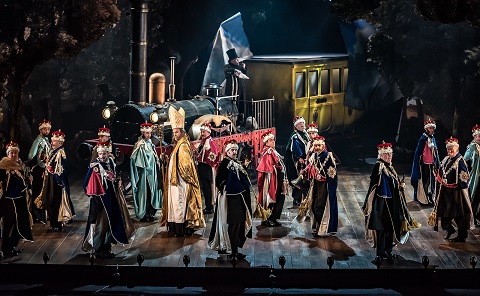 ENO Cast. Photo credit: Clive Barda.
ENO Cast. Photo credit: Clive Barda.
There are visual gags a-plenty, many involving animal puppetry, and they garner the guffaws: a sheep in the side-box peers bemusedly at proceedings; a unicorn’s horn doubles as a beer-tap; a cartoon cow capers; a panto-horse defecates. There’s spectacle, too, the apex of which (with a bathetic nod towards the triumphal march in Aida) is the arrival of the Lords in a steam-carriage which rips, literally, through the Elysian glade. The Lords proclaim their might and majesty in no uncertain terms: ‘Bow, bow, ye lower middle classes:/ Bow, bow, ye tradesmen, bow, ye masses! … We are peers of highest station,/ Paragons of legislation, Pillars of the British nation!’
There’s a touch of ‘Eric and Ernie’ about Iolanthe and Phyllis’ Act 1 love duet, ‘None Shall Part Us’, which is sung to the disruptive disorder created by two prop-movers who, blinded by their head-to-toe black ant-suits, rush around in circles depositing pastoral paraphernalia - more stuffed sheep, a shocking-pink flamingo. I did wonder if any in the audience were concentrating on the singing?
McCrystal has also invited some colleagues from the theatre world to join in the fun. Clive Mantle opens proceedings with an imperious pre-curtain house-keeping proclamation, spoofing Captain Shaw, the London Fire Brigade Chief to whom the Fairy Queen later addresses herself, wondering if his ‘brigade with cold cascade’ can quench her great love: Mantle subsequently proves deft with fire-extinguisher and sand-bucket, slaking the sparks that fly from the Queen’s wand. His wry welcome to the audience, which comprises ‘the middle classes … and … the upper-middle classes’, is as sharp as it would have been before Gilbert’s heterogeneous audiences.
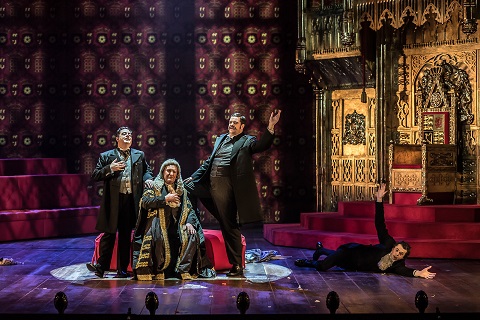 Ben Johnson, Andrew Shore, Ben McAteer and Richard Leeming. Photo credit: Clive Barda.
Ben Johnson, Andrew Shore, Ben McAteer and Richard Leeming. Photo credit: Clive Barda.
McCrystal demonstrates his mastery of slapstick and indulges his love of a knockabout in the Act 2 trio for Lord Tolloller, Lord Mountararat and the Lord Chancellor, ‘He who shies at such a prize’, in which Richard Leeming’s Page is the butt of ridicule, elbows and reprises. Shoved from the stage, bounced off the Woolsack, flipped over the red benches and dropped from the ceiling, he keeps coming back for more until he is unceremoniously thrust down the raised seat of the Royal Throne. The choreography and execution are superb, and Lemming exhibits the artless grace of Harold Lloyd - but I dread to think how many bruises he must have.
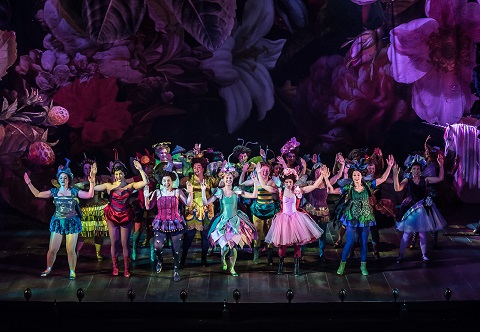 ENO Cast. Photo credit: Clive Barda.
ENO Cast. Photo credit: Clive Barda.
Despite the skilful jesting and burlesquing, it’s the visuals that win the prize though. The designs and costumes of Paul Brown, who died in November 2017 at the age of 57, enchantingly blend realism and romance. The interior of the Upper Chamber is mimicked in all its gilded glory, but Brown also whisks us into a Flower-Fairies grove in which outsize petals, buds, stamens entwine in slightly sinister quasi-erotic embraces: the pre-Raphaelites meet Richard Dadd. It’s a cornucopia of colour and texture, in which the Fairies - led by feisty Fleta (Flick Fernando) - swirl and stomp (‘Dainty little fairies’ these are not) dressed in an eye-popping riot of primary hues, their symbiosis with nature declared by their acorn hats, Dumbledore wings and trembling antennae.
The problem is that there is so much for the eye to take in - from stuffed dogs to dog-roses - that the singing, and the plot, take a back seat. Even Andrew Shore is quite subdued despite the flamboyance of the Chancellor’s black silk damask robe, trimmed with gold lace and frogging, though his enunciation was as crisply controlled as always, and there was no hint of strain or quiver as he cantered through Gilbert’s linguistic contraptions and contortions.
Ellie Laugharne was a pert and suitably girlish Phyllis; her soprano is bright and fresh, and she climbed cleanly to the stratosphere (and beyond, in a dog-whistle yell of passion), but Phyllis’ sweet demureness is rashly swept aside in an impressive tantrum in which she lambasts the ‘faithless’ Strephon and offers her heart to any peer who’ll have her - as long as she can be a countess. Marcus Farnsworth sounds wholesome and handsome as Strephon and essays some impressive dance-steps and leg-kicks.
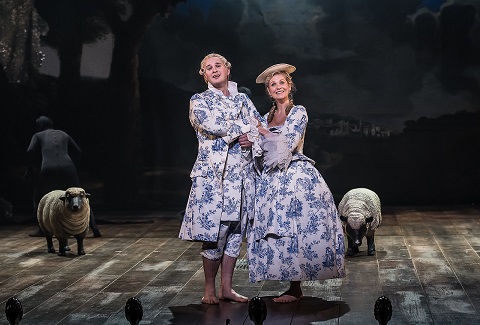 Marcus Farnsworth and Ellie Laugharne. Photo credit: Clive Barda.
Marcus Farnsworth and Ellie Laugharne. Photo credit: Clive Barda.
As Iolanthe, Samantha Price made the most of her Act 2 supplication to her former husband, while Yvonne Howard was a benevolent Queen: despite her Brunnhilde-breastplate with conical upholstery, she was more weightless than Wagnerian, landing from aloft with a graceful step. (As, on-stage, the Fairies trounced the Aristocrats, I couldn’t resist a wry smile at McCrystal’s thanks, in the programme, to ‘Lord Glendonbrook, whose generous funding at the eleventh hour enabled our fairies to fly’.)
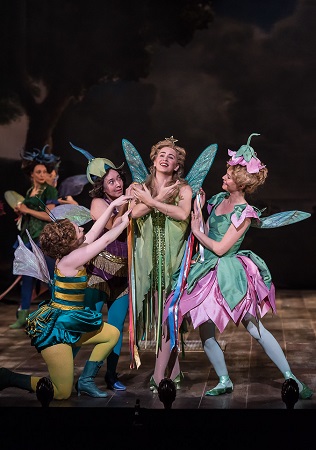 Llio Evans, Flick Ferdinando, Samantha Price and Joanne Appleby. Photo credit: Clive Barda.
Llio Evans, Flick Ferdinando, Samantha Price and Joanne Appleby. Photo credit: Clive Barda.
As the two Earls, Tolloller and Mountararat respectively, Ben Johnson and Ben McAteer show a pleasing instinct for the G&S idiom, and the self-deprecating satire of the latter’s ‘When Britain Really Ruled the Waves’, as Gilbert lampoons the two-party system, stingingly hit the mark: ‘When in that House MPs divide/If they’ve a brain and cerebellum, too/They’ve got to leave that brain outside/And vote just as their leaders tell ’em to.’ Barnaby Rea deserves special mention for the deadpan drollery of his Private Willis.
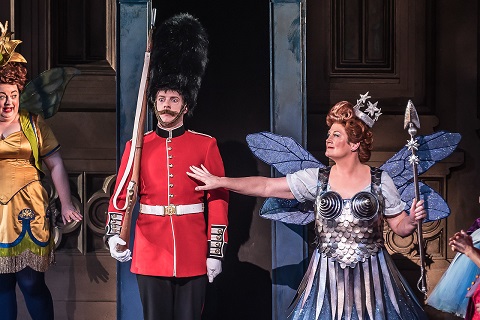 Barnaby Rea and Yvonne Howard. Photo credit: Clive Barda.
Barnaby Rea and Yvonne Howard. Photo credit: Clive Barda.
As mortal Lords and fairy Ladies, the ENO Chorus are excellent (and the audience can have some fun spotting a be-wheeled Boris and a be-spectacled Rees-Mogg among their ranks). The ENO Orchestra played well for conductor Timothy Henty, who did his best not to add to the obstacles against which his singers had to vie for our attention, though at times a little more zip would have raised the dramatic temperature.
In Gilbert’s day, all hereditary peers could join the House of Lords, which had the power to veto legislation proposed by the House of Commons, rights that were controversial and led to growing calls for reform and an end to the Lords’ veto. Gilbert’s ‘denouement’ seems to nod in this direction. The Lord Chancellor, faced with the Fairies’ storming of the Palace, makes a swift amendment to the law forbidding marriage between man and fairy: ‘Every fairy shall die who doesn’t marry a mortal’ (perhaps the current Lord Chief Justice could engineer a similar posthumous alternation to the referendum question posed in June 2016 …?)
The operettas of Gilbert & Sullivan reflected and (gently) ridiculed the world in which they were created and received, but they were not designed to bring about revolution. So, McCrystal lets the softish satire speak for itself. It’s all harmless fun, and the production is a vehicle for some visual magic - but, though both Fairies’ wands and Sullivan’s music occasionally sparkle, it doesn’t quite cast a spell.
Claire Seymour
Gilbert and Sullivan: Iolanthe
Iolanthe - Samantha Price, The Lord Chancellor - Andrew Shore, Queen of the Fairies - Yvonne Howard, Phyllis - Ellie Laugharne, Strephon - Marcus Farnswroth, Earl Tollloller - Ben Johnson, Earl Mountararat - Ben McAteer, Celia - Llio Evans, Leila - Joanne Appleby, Fleta - Flick Fernando, Private Willis - Barnaby Rea, Page - Richard Leeming, Captain Shaw - Clive Mantle; Director - Cal McCrystal, Conductor - Timothy Henty, Designer - Paul Brown, Lighting Designer - Tim Mitchell, Choreographer - Lizzi Gee, Chorus and Orchestra of English National Opera.
English National Opera, Coliseum, London; Tuesday 13th February 2018.
image=http://www.operatoday.com/Iolanthe%20cast.jpg image_description=Iolanthe, English National Opera product=yes product_title=Iolanthe, English National Opera product_by=A review by Claire Seymour product_id=Above: ENO castPhoto credit: Clive Barda
February 12, 2018
Il barbiere di Siviglia in Marseille
Rossini’s grand old (1816) comedy took the stage just now in Marseille’s fine, old (1787) opera house in the form of a Laurent Pelly production.
Pelly’s black and white production premiered this past December at Paris’ Théâtre des Champs Elysees. France’s most read newspaper Le Monde dubbed it a Barber in “demi-deuil” (half-mourning) and somehow dug up hints of tragedy in the storm — a bewildered Rosina rushed across a blank dark stage, dead leaves flying. Laurent Pelly’s conceit was in fact black ink on white paper, huge sheets of blank musical score paper on which Figaro tried to write out Lindoro’s “Se il mio nome bramate” (If you wish to know my name). In due time, however, for its moment “L’Inutile precauzione,” as backdrop, was fully notated (wittily it was not with the actual tune).
It was a complex conceit, the singers filling in, virtually, the notes missing on the scenery, or maybe the old warhorse having been performed so many times that Mr. Pelly found its story irrelevant — thus Il barbiere di Siviglia is only music, or maybe Mr. Pelly’s was saying that Il barbiere is music, though we already know this. Music was indeed a useless precaution in this scheme of things Barberiana.
Or something.
To be generous the five black lines of the musical staff did serve to imprison Rosina who appeared behind them when a square opened on a white page wall creating her balcony.
Mr. Pelly deployed his choruses and ensembles in geometric patterns, dissolving movement into abstracted, repeated motions (like music notation) reinforcing the music score conceit (the chorus mimed unison violins for Lindoro’s “Ecco ridente in cielo,” then stormed in as police brandishing folding metal music stands. These events were just the tip of the iceberg — there are lots of duets, trios, quartets and quintets, and one more chorus — gentlemen in regimented concert formation, sheets of music on their folding metal stands. It was a masterwork of stage choreography.
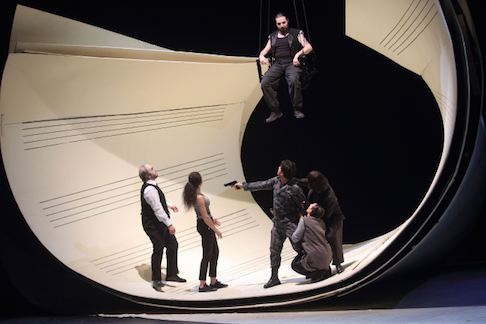 The drunken soldier, Figaro in swing
The drunken soldier, Figaro in swing
It was a long evening at the Marseille Opéra, a very long evening. [One of the most charming evenings I have ever passed in a theater was Laurent Pelly’s La Périchole (Stephanie d’Oustrac) at the Marseille Opéra back in 2002.]
Conductor Roberto Rizzi Brignoli was determined to make Rossini’s comic masterpiece into something it is not — Mozart, with touches of Cilea. The Barber’s overture was a caricature of this oft concert-performed masterpiece, this maestro insisting on determined, very determined tempos and very shaped phrases. The opening oboe solo was so extended that you could feel the player’s face turning red. Missing from the entire evening was the joy of music making, the joy of singing and the release of musical spirit when a vocal line explodes into fioratura.
The only carry over from the Paris cast was to have been the Figaro of Florian Sempey, but the diseases of the season claimed veteran baritone Carlos Chausson’s Bartolo at the very last minute, thus Spaniard Pablo Ruiz [the opera singer, not the pop singer of the same name] from the Paris cast jumped in.
It is surely possible to say that young baritone Florian Sempey will be (probably is) the reigning Figaro of our day. Less a look-alike of an imagined young Rossini now than in his Pesaro Figaro in 2015 he once again succeeded in bringing perfect Rossinian spirit to this comic hero. Mr. Sempey has facile, graceful movement on stage, and facile command of Rossini’s vocal requirements, singing in strongly focused, beautiful tone. Of infectious energy Mr. Sempey's Figaro in this production had no easily apparent context, thus there was no dramatic focus and this rendered his fine performance somewhat overbearing.
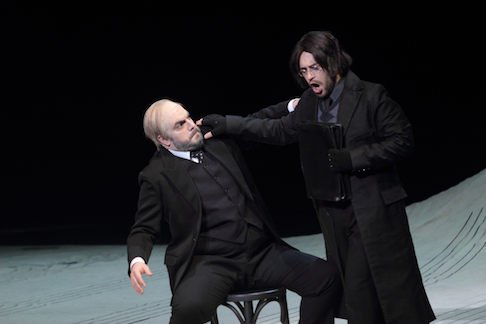 Bartolo and Basilio
Bartolo and Basilio
There can be no argument that Stephanie d’Oustrac can create fascinating character, witness her recent successes as Carmen in wildly different productions. Certainly her Rosina in this production is a masterpiece of character — a sort of “valley girl” or whatever the French equivalent is. La d’Oustrac’s Rosina is more than anything else fun, and she is not a bit frightened by the prospect of marrying Bartolo. Her “una voce poco fa” was so inflected with personality that you forgot it was being sung. Although her performance was vocally secure and virtuoso indeed, I did miss a purely sung Rossini Rosina.
With the powerhouse conducting, the overwhelming staging conceit, and the surpassing performances of Mme. d’Oustrac and Mr. Sempey the balance of the cast struggled to make impression. Lindoro was ably if softly sung by French tenor Philippe Talbot, Spanish baritone Pablo Ruiz was an able, persuasive Bartolo, Young Italian bass Mirco Palazzi was Basilio, paired in appearance with Lindoro, a subtle casting touch. Annunziata Vestri was a lively, big voiced Berta and did make an impression. Fiorello was well presented by local Marseille singer Mikhaël Piccone.
Michael Milenski
Cast and production information:
Rosina: Stéphanie d’Oustrac; Berta: Annunziata Vestri; Comte Almaviva: Philippe Talbot; Figaro: Florian Sempey; Bartolo: Pablo Ruiz; Basilio: Mirco Palazzi; Fiorello: Mikhaël Piccone; Un Ufficiale: Michel Vaissiere; Ambroggio: Jean-Luc Epitalon. Orchestre et Chœur de l’Opéra de Marseille. Conductor: Roberto Rizzi Brignoli; Mise en scène, décors, costumes: Laurent Pelly; Lighting: Joël Adam. Opéra de Marseille, February 9, 2018
image=http://www.operatoday.com/Barber_Marseille1.png
product=yes
product_title=Il barbiere di Siviglia in Marseille
product_by=A review by Michael Milenski
product_id=Above: Florian Sempey as Figaro, Stephanie d'Oustrac as Rosina [All photos copyright Christian Dresse, courtesy of Opéra de Marseille]
February 10, 2018
Riveting Maria de San Diego
This dramatically intense production fairly exploded off the intimate stage of the Lyceum Theatre, and its slight thrust proved a congenial playing space for this highly personal character study.
The titular character of Maria is a streetwalker, born to public squalor (as the script says) “one day when God was drunk … with a curse in her voice.” She embraces the alluring beat and sinuous melody of the tango, however her “fatal passion” prompts the ire of other street denizens who kill her. Maria, now pregnant after death, descends into a murky Purgatory where she is challenged by spectral visitors who torment her soul. Eventually, she returns to the haunt the sordid streets of Buenos Aires as a spirit (Shadow Maria) and give birth to a new young Maria (which may be her own self).
If the libretto sounds more knotty than naughty, director-choreographer John de los Santos has embraced the macabre imagery and dramatic non-sequiturs and devised a richly varied, vividly theatrical, high energy staging that swept us along in willing abandon. His total belief in the scattering of images and intertwining of subplots allowed us to suspend our disbelief, making satisfying order out of the chaotic jumble of religious artifacts, rituals, skulls, masks and metaphors.
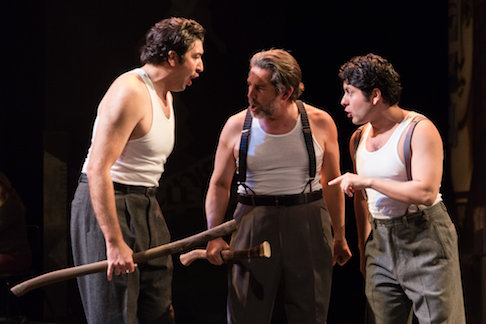 (L-R) Baritone Bernardo Bermuda, bass Walter DuMelle, and tenor Rodolfo Ruiz-Velasco (male ensemble)
(L-R) Baritone Bernardo Bermuda, bass Walter DuMelle, and tenor Rodolfo Ruiz-Velasco (male ensemble)
Mr. de los Santos is ably supported by his accomplished design team. Liliana Duque Piñeiro has crafted multi-purpose scenery, replete with gritty texturing, that can be turned, moved and unfolded like a morbid oversized retabla. Lighting designer Jason Bieber has effectively lit the proceedings with brooding, sultry illumination that achieves the dual effect of being by turns gaily colorful and soberly suffocating. Ingrid Helton’s inspired costumes ran the gamut from homely peasant wear to fantastical tribal wear, making full use of an orgy of color and patterns
The overwhelming element that makes all of this disjointed story-telling not just comprehensible but ingratiating is the masterful score. Conductor Bruce Stasyna led an assured reading, full of color and undulating fire. He not only coaxed beautifully authentic ensemble playing from his accomplished ensemble, but also allowed the skilled bandoneon, piano, and guitar soloists all the room they needed to perfume the instrumentation with a heady individuality.
Having seen this piece in two different incarnations, I have come to the belief that it does not really take a trained opera singer to succeed in the title role. The lovely Audrey Babcock immersed herself in the part, proving to be dramatically compelling. Her list of credits in the program documents that she has had national success in major traditional singing roles. The range of Maria seems to lie mostly in chest voice, and Ms. Babcock certainly sings with polish and assurance. The other interpreter I saw did the same. But I wonder if a young, unabashed outright belter might not bring even more zing to the mix. That said, Audrey was a riveting stage presence and anchored the show.
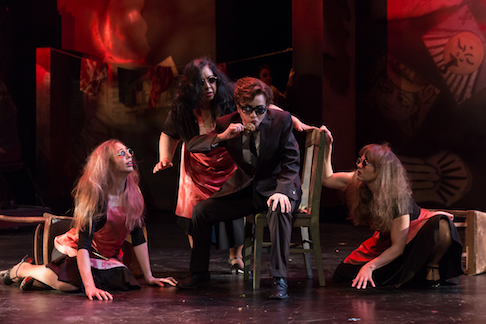 (L-R) Soprano Sarabeth Belon (ensemble), mezzo-soprano Sandra Camarena (ensemble), actor Celeste Lanuza (seated, El Duende), and mezzo-soprano Laura Bueno (ensemble)
(L-R) Soprano Sarabeth Belon (ensemble), mezzo-soprano Sandra Camarena (ensemble), actor Celeste Lanuza (seated, El Duende), and mezzo-soprano Laura Bueno (ensemble)
As her sometime lover, El Payador, strapping and handsome Paul La Rosa sings with a burnished, throbbing tone of considerable beauty, and earns his Barihunk credentials in a steamy bedroom encounter with Maria. El Duende is an impish character that drives the narrative. Diminutive actress Celeste Lanuza gives quite a tour de force traversal of the role, morphing easily from one mischievous, meddling, scolding personage to another.
The excellent chorus meticulously executed some of the score’s trickiest passages, chanting in irregular rhythms, coloring vocal solos with dramatic variety, and switching back and forth effortlessly to portray a panoply of characters of wildly differing stations. The ensemble included Laura Bueno, Sarabeth Belon, Bernardo Bermudez, Sandra Camarena; Walter DuMelle, and Rodolfo Ruiz-Velasco. The appealing twin dancers Laurence Gonzalez and Lester Gonzalez (of California Ballet) added immeasurably to the evening, especially in their featured turn as tango-dancing skeletons (I am not making this up!).
I heartily commend San Diego Opera for such a daring and artistically satisfying fresh new production, which, if the sold-out houses are any indication, is generating new audiences for the operatic art form.
James Sohre
Cast and production information:
Maria: Audrey Babcock; El Payador: Paul La Rosa; El Duende: Celeste Lanuza; Ensemble: Laura Bueno, Sarabeth Belon, Bernardo Bermudez, Sandra Camarena; Walter DuMelle, Rodolfo Ruiz-Velasco; Dancers: Laurence Gonzalez, Lester Gonzalez; Conductor: Bruce Stasyna; Director: John de los Santos. Set Design: Liliana Duque Piñeiro; Costume Design: Ingrid Helton; Lighting Design: Jason Bieber.
image=http://www.operatoday.com/KarliCadel-SDOpera-MariaBuenosAires-8396.png image_description=Mezzo-soprano Audrey Babcock (Maria) and baritone Paul La Rosa (El Payador) [Photo by Karli Cadel] product=yes product_title=Astor Piazzolla: Maria de Buenos Aires product_by=A review by James Sohre product_id=Above: Mezzo-soprano Audrey Babcock (Maria) and baritone Paul La Rosa (El Payador)Photos by Karli Cadel
February 9, 2018
La Walkyrie in Toulouse
The Joel production, here revived by stage director Sandra Pocceschi (a Castellucci assistant), approached masterpiece status, exploiting the intimacies and the unique acoustic of the Théâtre du Capitole, enjoying the splendors of its excellent orchestra, and profiting from an essentially perfect cast.
It is a rare pleasure to address an isolated Walküre in this recent (10 or so years) avalanche of entire Rings worldwide. Die Walküre is the one of the Ring’s operas that easily stands alone as a human document without need to be absorbed into larger 19th century philosophical concepts.
The Joel staging, in collaboration with Giorgio Strehler’s designers Ezio Frigerio (scenery) and Franca Squarciapino (costumes) eschews concept (no California gold rush for example), instead it explores a theatrical language (style) to expound the multiple crises of Wotan, the deeply human feelings of Brunnhilde, the forbidden love of Sieglinde and Siegmund, and the outrage of Fricka and Hunding.
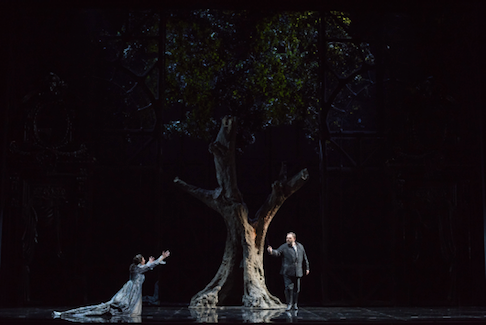 Sieglinde and Siegmund
Sieglinde and Siegmund
The language is of the utmost simplicity. The set is a changing montage of ever present imperial architectural elements in front of a huge steel superstructure, though there is the sword-bearing abstracted tree trunk in the beginning. Costuming is in rich garments of basically medieval cut in grays and blacks and pastel hues.
Wagner imagined his music drama with its orchestra as the primary voice. The Théâtre du Capitole’s pit is very present, both visually and acoustically, its forte’s and then triple forte’s roar without impeding clear projection of voice from the stage. The intimate comments of Wagner’s much used bass clarinet, oboe and bassoon are no less present in their isolated purity.
Wagner’s poem flowed from the stage, its words never obfuscated, only enriched by orchestral colors. Wagner’s actors were sculpturally placed for their extended monologues, their extended stylized postures (a head hung for example) illustrated the emotions flowing from the orchestra. Gestures were broad, and when they occurred they were quite pointed — like the gazes of recognition between Siegmund and Sieglinde, or Wotan’s slapping of balustrades in his frustration or anger.
The dancing of the flames that surrounded Brünnhilde then burst (one giant flash of real flame, then smoke and lights) into a magnificent force of conflagration that the father Wotan knew would protect his daughter. The Joel staging defined pure music drama, as the Théâtre du Capitole’s orchestra traced the evolution of emotions of human love that made this nearly 6 hour Die Walküre finally into a uniquely enjoyable Wagnerian experience.
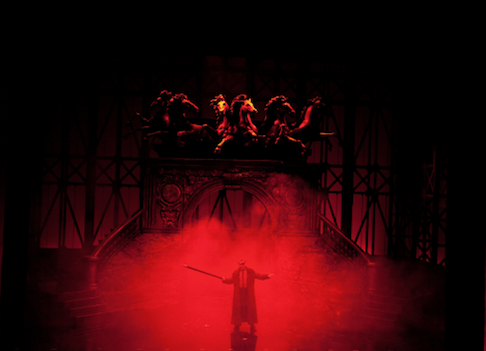 Wotan
Wotan
And we leave the story at that.
Russian mezzo soprano Anna Smirnova made her dramatic soprano debut as this Brünnhilde. Her voice is of extraordinary power, and of a richness that amplified the surpassing humanity of Wotan’s favorite daughter. The youth of her voice was perfect for the innocence of the Walküre Brünnhilde (she is 35 years old), and her voice retained its youthful bloom to the last, intense moments of her final encounter with her father. Note that as a mezzo she will sing Eboli in L.A. Opera’s upcoming Don Carlo.
Polish bass-baritone Tomasz Konieczny brought unusually sharp vocal edge to Wotan, a god in utmost agony — he dictated the death of his son, and faced the rebellion of his most loved daughter. Konieczny was an actor in Poland before he became a singer. His Wotan was of intense concentration, his troubled postures added force to his defeat by his wife Fricka, his berating of the Valkyries was wearied and sharply apprehensive. Note that he sings Wotan in the Vienna State Opera’s upcoming Ring.
Strauss specialist, 50 years-old German soprano Daniela Sindram made her role debut as Sieglinde. She possesses a purity of voice that added pathos to her adultery and incest and her impending maternity, and impeccable technique that revealed the anguish of her attachment to her brother and lover. Likewise in his role debut as Siegmund, German tenor Michael König exposed a purity of youthful helden tenor sound that made his remembrances of his earthly father vivid, and made his declaration to Brünnhilde of his love for Sieglinde persuasive.
Russian bass Dimitry Ivashchenko was a menacing, beautifully sung Hunding. German mezzo Elena Zhidkova made Fricka appropriately shrill and rigid. The Valkyries were a noisy lot, wandering around a Valhalla courtyard amidst the piles of fallen heroes in bloody underclothes that they unceremoniously (bizarrely) dragged around like dead meat.
This Die Walküre began and ended in the pit. German conductor Claus Peter Flor, long associated with Toulouse, oversaw this Wagnerian masterpiece with musical clarity and Wagnerian insight, magnifying its humanity in his precisely dramatic reading of the score. The Théâtre du Capitole orchestra responded with utmost concentration, swelling to magnificent climaxes, joyfully popping the flames in its overture and again at its finale.
Michael Milenski
Cast and production information:
Brünnhilde; Anna Smirnova; Siegmund: Michael König; Wotan: Tomasz Konieczny; Sieglinde: Daniela Sindram; Fricka: Elena Zhidkova; Hunding: Dimitry Ivashchenko; Gerhilde: Marie-Laure Garnier; Ortlinde: Oksana Sekerina; Waltraute: Pilar Vázquez; Schwertleite: Daryl Freedman; Helmwige: Sonja Mühleck: Siegrune: Szilvia Vörös; Grimgerde: Karin Lovelius; Rossweisse: Ekaterina Egorova. Orchestra of the Théâtre du Capitole. Conductor: Claus Peter Flor; Mise en scène: Nicolas Joel mise en scène (by Sandra Pocceschi); Scenery: Ezio Frigerio; Costumes: Franca Squarciapino; Lighting: Vinicio Cheli. Théâtre du Capitole, Toulouse, France, February 6, 2018).
image=http://www.operatoday.com/Walkure_Toulouse1.png
product=yes
product_title=Die Walküre in Toulouse
product_by=A review by Michael Milenski
product_id=Above: Anna Smirnova as Brünnhilde {this and following photo copyright David Herrero, third photo copyright Frederic Maligne, all photos courtesy of the Théâtre du Capitole.}
February 8, 2018
Barrie Kosky's Carmen at Covent Garden
In a letter to Nadezhda von Meck, written in 1878, reflecting on his admiration for developments in French music in general and Carmen in particular, Tchaikovsky predicted that in ‘ten years hence, it will become the most popular opera in the world’. He was right: 150 years on Carmen is probably the best-known, most oft-performed opera, adapted and translated into myriad other art forms from Oscar Hammerstein’s 1943 musical Carmen Jones, to Matthew Bourne’s homoerotic balletThe Car Man (2000) to Jean-Luc Goddard’s 1983 film, First Name: Carmen.
Kosky seems to have set out to wipe the slate clean. And, the first thing to be jettisoned is Spain: Carmen has lost her castanets. In an interview published in the New York Times , the director explained that he had told his designer, Katrin Lea Tag, ‘We are not setting the production in any place. We don’t need to worry about what country are we in; we can do whatever we bloody well like.’ No matter that Spain - as envisaged by hispano-manic 19th-century France - is embedded in both text and score. There’s no place for Prosper Mérimée’s racial and social ideology in this production, nor for Sevillian sunshine and cigarette factories.
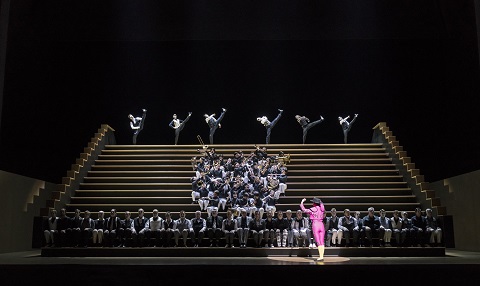 Photo credit: Bill Cooper.
Photo credit: Bill Cooper.
The ‘set’ comprises a stage-wide staircase which slides forward and back but which otherwise presents a stationary ‘terrace’, up and down which cast and chorus stride and clamber athletically. We are not in Andalusia at all, rather in a Greek amphitheatre or Roman Coliseum. Or, perhaps, we are at the bull-ring, though this Carmen certainly does not plan to be thrown to the lions or thrust by the matador’s etosque. It’s she who is wearing the traje de luces, flamboyant in cerise with gold stockings, when she appears at the top of the staircase and surveys all with a brazen haughtiness.
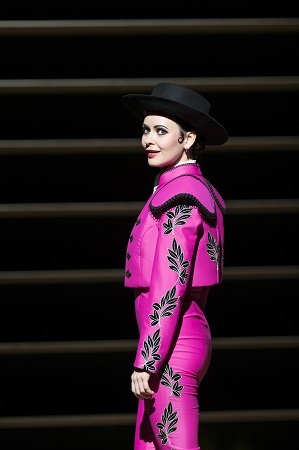 Anna Goryachova (Carmen). Photo credit: Bill Cooper.
Anna Goryachova (Carmen). Photo credit: Bill Cooper.
Kosky’s Carmen is a role-playing chameleon. She responds to the exalted appeals of the adulating crowd with a ‘habanera - but not as you know it’. Lumbering down the steps in a gorilla suit - woman as wild beast, then, not ‘oiseau rebelle’ - Carmen is divested of her claws and paws by fawning dancers before ripping off her fur to reveal a modern, sharp suit: tight black trousers, white shirt, narrow tie - to which the dancers add gold stilettos. She swaps these for black ankle boots when she viciously kicks a cigarette-factory worker down the stops, and she constantly re-invents herself, trading a flamenco-tinted black dress for a feathered flapper gown. Finally, she dons a lustrous black evening dress, a subversion of a bridal gown, its gargantuan, fateful train, fanning the staircase like a peacock’s invitation, made iridescent by Joachim Klein’s lighting.
Alongside Escamillio (resplendent in gold with pink silk stockings, thus inverting Carmen’s own initial costume), Carmen’s black veil gives her a mourning air - more Dido than diva. Does the immobilising train trap her? Previously, she had strutted angrily, proudly across the stage, her hands tied by Don José’s rope: but, there are two ends to a rope and it was ambiguous just who controlled the leash. Indeed, it wasn’t long before José found himself bound, ridiculed and imprisoned. In the final scene, the desperate soldier lunges for her train but it seems to suffocate him when she simply rips it from her waist. Free from the man perhaps, but not from his knife.
It’s hard, though, to care about an ‘actor’ who mutates from masculine to feminine via androgyny and who seems to have no emotional connection with any one else, so obsessed is she with constructing and controlling her ‘self’. There’s certainly no hint of sexual chemistry with José. Standing stage-centre or atop the staircase, the characters face the auditorium and sing to us, never to each other. And, this emotional sterility is echoed by the overall tone of Kosky’s production which seems to hold the passion and pathos of Bizet’s opera at a distance, pinched by a pair of ironic tongs. Kosky references vaudeville, circus and Weimar cabaret as his six dancers tap, shuffle, twirl and swing their way around Carmen and the cast, in choreographer Otto Pinchler’s dashing and dizzying routines, but the relentless camp razzmatazz becomes rather wearing. Apparently Kosky told his cast, ‘You’re in an operetta. You are not in “le grand opéra”’, and it really is one long sardonic joke, as if Kosky has mis-translated ‘opéra comique’.
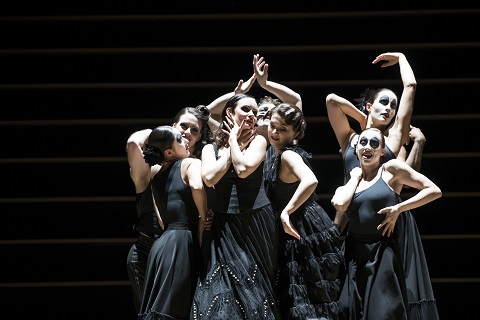 Jacquelyn Stucker as Frasquita, Anna Goryachova as Carmen, Aigul Akhmetshina as Mercédès. Photo credit: Bill Cooper.
Jacquelyn Stucker as Frasquita, Anna Goryachova as Carmen, Aigul Akhmetshina as Mercédès. Photo credit: Bill Cooper.
Of course, he hasn’t. But, don’t expect any spoken dialogue, either. Instead, a pre-recorded female voice (Claude de Deno as ‘The Voice of Carmen’) reverberates in the theatre, relating, with breathy sultriness, an amalgam of Mérimée’s narration and some stage directions. Sometimes the latter prompted a snigger, as when the explanation ‘When the curtain rises, the audience see a bleak hillside’ cued a stage-picture of sleeping smugglers scattered across the staircase-terraces. The recorded voice also further distances us from the action. Yes, Mérimée’s novella has a double-frame which allows the tale of violent disorder and murderous Otherness to be controlled and contained by the logical narrative of the erudite Frenchman who has travelled to Spain on an archaeological quest. But, Meilhac and Halévy had good reasons for excising this framing device when composing the libretto. In the theatre we need action, not narration: Kosky ‘tells’ us what’s happening, and this saves him from having to ‘show’ us, or from having to link the vignettes into a coherent drama on stage.
The narration also contributes to the long running-time: the first two acts form a first half lasting two hours, and the final act lacks impetus. There is ‘extra’ music, too. Arguing that there is no definitive edition of Carmen (in a programme article, Michael Rot, who prepared the critical edition used here, explains that there are ten extant versions of the opera dating from 1874 to the first publication of the score on 1877), Kosky has restored some numbers that were cut either before or after the premiere in 1875. These include a ‘Scène et pantomime’ after the Act 1 Introduction, in which Moralès invites the audience to watch attempted rendezvous between a pretty young wife and a handsome Spaniard under the eyes her aged husband; an extended duet for Micaëla and José, and the original Habanera which Kosky appends to the first part of the more familiar dance-song, pasting over the join.
However, although various factors - such as Bizet’s death three months after the premiere, Ludovic Halévy’s destruction of the original rehearsal notes, and the ambiguity of the autograph score into which Ernest Guiraud’s subsequent recitatives were bound - do complicate the ‘authenticity’ of any one version, the composer did himself correct the first-published vocal score which Choudens produced at the time of the first performance. I couldn’t find any dramatic reason for including this extra material, though it had novelty interest.
Making her house debut, Russian mezzo Anna Goryachova acted superbly in the title role. She was a tense and menacing Carmen, confident and contemptuous in equal measure. This Carmen was cruelly sardonic rather than overtly sexy, but Goryachova’s mezzo has an alluring darkness. She tired a little towards the close and this resulted in a few intonation problems. I was not particularly taken with Francesco Meli’s José, though many in the House were obviously appreciative. There were some unpleasant rough edges as he forced his fairly light tenor to produce a full-bodied forte and he seemed unable to begin a phrase without swooping to the note from beneath. His piano singing was more sensitive, but he veered from loud to soft rather unevenly.
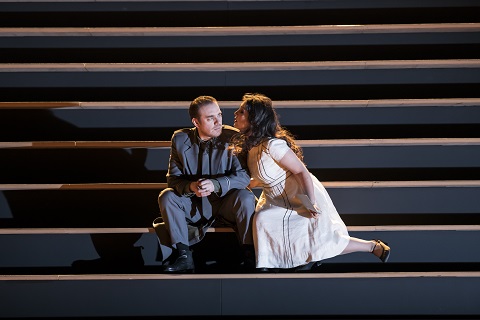 Francesco Meli as Don José, Kristina Mkhitaryan as Micaëla. Photo credit: Bill Cooper.
Francesco Meli as Don José, Kristina Mkhitaryan as Micaëla. Photo credit: Bill Cooper.
Kristina Mkhitaryan has a big voice and its power at times belied Micaëla’s delicacy, but her Act 3 aria was well sung. Kosky didn’t seem very interested in assimilating this character into his concept, though; her white dress marked her as the odd one out among the otherwise ‘shades of black and grey’ costumes, and it wasn’t clear what this young girl who sings of real human emotions and relationships was doing amid the play-acting artistes - such as Kostas Smoriginas’ Escamillo whose hyperbolic triumphal entry had a whiff of pantomime about it. In the aforementioned interview, Kosky remarked, ‘I said, “Let’s just put Escamillo in a fabulous toreador’s costume.” When he comes on, everyone’s waiting for that number — and we turn it into a huge number. I said, “Just make sure the toreador costume looks fabulous, and it solves the problem”,’ but I’m not sure that it does/did. Smoriginas was secure but a little underwhelming vocally, especially at the bottom, and no amount of gold lame or silver sparkle was going to change that.
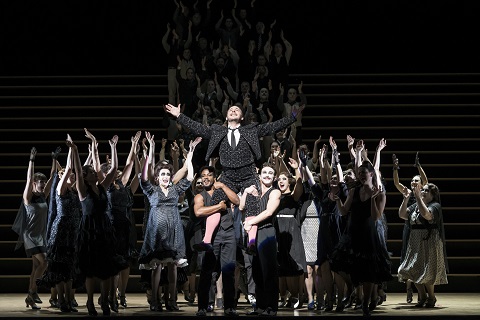 Kostas Smoriginas as Escamillo. Photo credit: Bill Cooper.
Kostas Smoriginas as Escamillo. Photo credit: Bill Cooper.
Carmen metamorphoses, but no one ‘develops’; the result is that David Soar’s Zuniga and Gyula Nagy’s Moralès, though well-sung, don’t make much impact, though as Frasquita and Mercédès, respectively, Jacquelyn Stucker and Aigul Akhmetshina offer brightness and vivacity to complete Carmen’s dark allure, and give energetic, committed performances.
Conductor Jakub Hrůša took us unawares at the start, sweeping into the toreador’s theme which commences the overture as the House lights plunged us into darkness, breaking off our chatter. Hrůša adopted fairly swift tempi and conjured a delicacy and subtlety in the pit that was absent from the stage. The Act 3 prelude was beautifully played, and there as some fine horn-playing in Micaëla’s aria. The ROH Chorus were similarly on, characteristically, excellent form.
Kosky seeks to crystallise extreme emotions in a series of essentially self-contained tableaux but in so doing he removes these emotions from any dramatic continuum or genuine human context and interchange. Who is this Carmen? A femme fatale with a death-wish? A bel canto stereotype whose destruction we demand but whose voice transcends death? An archetype? An actress?
In the final moments, she rises from the ground with an ironic shrug which is both Carmen’s and Kosky’s last word. A frustrating one. Carmen has acted her story, as she wants it told, and she is reborn to tell it again. Her life is an act: there’s nothing ‘real’ - and while we can live without visual realism - the lack of both verismo passion and simple human feeling are more troubling.
Claire Seymour
Bizet: Carmen
Carmen - Anna Goryachova, Don José - Francesco Meli, Escamillo - Kostas Smoriginas, Micaëla - Kristina Mkhitaryan, Zuniga - David Soar, Frasquita - Jacquelyn Stucker, Mercédès - Aigul Akhmetshina, Le Dancaïre - Pierre Doyen, Le Remendado - Jean-Paul Fouchécourt, Moralès - Gyula Nagy; Director - Barrie Kosky, Conductor - Jakub Hrůša, Designer - Katrin Lea Tag, Lighting designer - Joachim Klein, Choreographer - Otto Pichler, Dramaturg - Zsolt Horpácsy, Chorus and Orchestra of the Royal Opera House.
Royal Opera House, Covent Garden, London; Tuesday 6th February 2018.
image=http://www.operatoday.com/Carmen%20shrug.jpg image_description=Barrie Kosky’sCarmen at the ROH product=yes product_title=Barrie Kosky’s Carmen at the ROH product_by=A review by Claire Seymour product_id=Above: Anna Goryachova (Carmen)Photo credit: Bill Cooper
February 7, 2018
Candide at Arizona Opera
Bernstein’s wife, Felicia Cohn Montealegre, also worked with him on the text of The Old Lady’s tango, “I Am Easily Assimilated.”
Candide is based on a work by Voltaire, who wrote about the French Enlightenment’s progressive ideas. In his 1759 novel, Candide, he attacked intolerance, corruption, and established religion. Early in the 1950s, playwright Lillian Hellman approached Leonard Bernstein with the idea of making the Voltaire novel into a Broadway play for which Bernstein would supply the incidental music. Bernstein loved the subject and suggested that it be turned into an operetta. With song lyrics by Hellman, Bernstein, Richard Wilbur, and John LaTouche, Candide opened on Broadway on December 1, 1956, and ran for 73 performances. Later versions of the show have had much longer runs.
Although this sprawling work of musical genius takes place in various parts of Europe and South America, director Christopher Mattaliano turned its many wide-ranging scenes into a performable and memorable show. Jerome Sirlin’s projections and Robert Wierzel’s lighting designs turned the scenery into backgrounds that actively suggested the show’s myriad settings. James Scott’s colorful and functional costumes reminded patrons that the story took place in the eighteenth century. Because this work is a modern show rather then an opera, it included sound design by theatrical veteran Lew Mead.
In Phoenix, Miles Mykkanen was Candide, the man who originally believed he lived in the best of all possible worlds. He sang with a pleasant resonant sound and seemed to be enjoying the part immensely. The star of the show was Marion Roose Pullin Studio Artist Katrina Galka as Cunegonde. Although she is still at the beginning of her career, the charismatic Galka has a silvery voice that maintains its continuity from top to bottom and on Friday evening she seemed to hold the audience in the palm of her hand. Beginning with the sad story of her fall into prostitution, Galka’s Cunegonde showed that she would never allow her situation to dull her sparkling personality. Her aria, “Glitter and Be Gay” was the highlight of the evening.
Curt Olds was a fatherly Pangloss who morphed into multiple smaller parts as called for in the wide spread tale. Catherine Cook, who was scheduled to sing The Old Lady, was ill, so Ann McMahon Quintero was a last minute substitute who sang her Klezmer-infused tango with smoky tones and garnered quite a few laughs with her antics. Her dance to Amy Beth Frankel’s capable choreography was most amusing.
Jarrett Porter was an outstanding Maximilian and a commanding Captain while Stephanie Sanchez was a smooth-toned and sexy Paquette. Anthony Ciaramitaro proved his versatility with capable portryals of the Governor, Vanderdendur, the Grand Inquisitor, and Ragotski. Dale Dreyfoos excelled as the multiple characters of the Baron, the Bulgar King, Don Issachar, and a few more ordinary folks. Thomas Strawser, Kathleen Berger and Studio Artist Zachary Owen all showed their mettle in multiple small parts.
Henri Venanzi’s most excellent choral ensemble easily handled all the varied styles of music that Bernstein chose to write in this fascinating work. Conductor Joseph Colaneri’s tempi propelled the story forward and his wide range of dynamics underscored the dramatic conflicts. His interpretation of the Candide score, which includes everything from Gregorian Chant to tango, was most impressive. It was an unusual production and Arizona Opera made it truly memorable.
Maria Nockin
Cast and production information:
Candide, Miles Mykkanen; Pangloss, Voltaire, Cacambo, Martin, Curt Olds; Cunegonde, Katrina Galka; The Old Lady, Ann McMahon Quintero; Maximillian, Captain, Jarett Porter; Governor, Vanderdendur, Grand Inquisitor, Ragotski, Anthony Ciaramitaro; Paquette, Stephanie Sanchez; Baron, Bulgar King, Lisbon Man, Don Issachar, Waiter, Aide, Native, Dale Dreyfoos; Painter, Officer, James, Informer, Waitress, Archbishop, Father Bernard, Native, Sailor, Zachary Owen; Officer, Sailor, Informer, Waiter, Slave Driver, Native, Crook, Attendant, Wise Man, Thomas Strawser; Baroness, Lisbon Woman, Waitress, Guest, Kathleen Berger; Señores, Francisco Renteria and Sergio Celis; Inquisitors, Judges, Dennis Tamblin, Ronald Eldridge, Jeffrey Stevens; Conductor, Joseph Colaneri; Stage Director, Christopher Mattaliano; Chorusmaster, Henri Venanzi; Choreographer, Amy Beth Frankel; Scenery and Projection Designer, Jerome Sirlin; Costume Designer, James Scott; Lighting Designer, Robert Wierzel; Sound Designer, Lew Mead.
image=http://www.operatoday.com/Candide_Tim%20Trumble_04.png
image_description=Cunegonde Katrina Galka and Candide Miles Mykkonen [Photo by Tim Trumble]
product=yes
product_title=Candide at Arizona Opera
product_by=A review by Maria Nockin
product_id=Above: Cunegonde Katrina Galka and Candide Miles Mykkonen [Photo by Tim Trumble]
February 5, 2018
Satyagraha at English National Opera
In recent years, there has been a tendency with many of Glass’s scores (one thinks of the First Violin Concerto, for example) to revisit his tempos and this was very notable in the pacing of the opera this time round. It made for a very long evening, but the upside was a transformation in the music that added much needed depth and emotional integrity to a work that sometimes seems to be missing both. A downside, of course, is that in an opera that really has such minimal narrative to keep it moving one’s concentration and endurance is tested to the limits. This sometimes felt like Parsifal on benzodiazepine, or an over-dramatized Bach oratorio - but it is to the credit of a splendid cast and a brilliantly engaged conductor that this performance was so spellbinding. For a first night, which so often isn’t perfect, this was as close to ideal as I’ve heard in many years.
If Satyagraha is the best of the three profile operas it is largely because it has neither the astringency ofEinstein on the Beach nor the monotonal repetitiveness of Akhnaten. Minimalism can sometimes sound very temporal and hollow, but here at such a broad tempo (take, for example, the scene in Act II with the burning of the passes which could have almost been lifted from the pages of re-orchestrated Bach) and the effect was transcendental. That is not to say that the score doesn’t motor onwards like a typewriter - the male chorus, with their taunts of “Ha! Ha! Ha!” were acidic against the ENO woodwind - not always exactly synchronised - but this is a long scene and hugely demanding. The closing pages of Act III, where Gandhi stands beneath the plinth of Martin Luther King against darkening clouds that foreshadow the assassinations of both men, was devastating, yet taken at this chosen speed you felt it was never-ending. The music felt as oppressive as the bleakness of the imagery on stage; chromatic shifts in key from the orchestra were like changing projected film slides on a permanent loop.
For a composer so heavily involved in composing for film, it’s perhaps not surprising that ENO’s production of Satyagraha should acknowledge that debt, however tangentially. Whether it’s a steamship rolling slowly across the corrugated steel that remains the constant backdrop for this staging, or film of civil rights marches in support of King’s speech, the camera is both a means of projection and a means of communication. Before film, there was newspaper and here it is reimagined in every possible way. It is used as a means of peaceful protest, it is used as a means of violence, where the male chorus “stone” Gandhi into submission. It is used as a backdrop against which Sanskrit words are projected, it is used to cultivate fear and terror, where unspeakable violence is carried out behind curtains of newspaper in the darkness of the shadows. Before newspapers, there was just the word. Great tablets inscribed with single Sanskrit letters descend like monolithic slabs that recall the Ten Commandments.
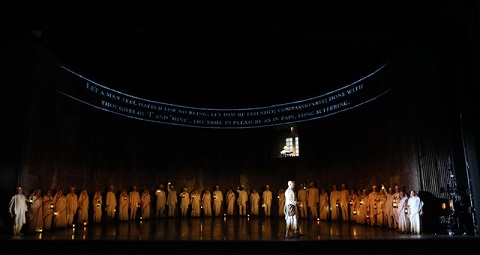 ENO, Satyagraha Photo credit: Douglas Cooper.
ENO, Satyagraha Photo credit: Douglas Cooper.
Phelim McDermott and Julian Crouch, the director and designer of this production, have made this opera as theatrical as possible to stem the awkwardness of its lack of narrative. There is an overwhelming sense of austerity, poverty and hardship to the corrugated township of late nineteenth century and early twentieth century South Africa here - and it even extends to the muddied, frayed bottoms of the women’s long dresses as they are dragged through the dirt. The attention to detail misses very little. This is a recycled staging, where the wicker baskets of Tolstoy Farm are magically transformed into giant fish, where torn and scrunched up newspapers are turned into huge monsters and disfigured puppets and where endless streams of sticky tape that served firstly as a fence are then torn down and folded like origami into a giant stick figure of a hangman. You are often awestruck by the acrobatics of Skills Ensemble. Not everything was perfect, but when it worked you couldn’t take your eyes off it. A scene where an image of the earth, spinning like a globe, appeared on a round table, for it and one of the performers, to slowly be lifted towards the roof of the stage was stunning.
Despite these sweepingly dramatic moments, so much of Satyagraha remains static. This production doesn’t wear its philosophy lightly. Excerpts from the Gita, or the principles of ‘truth force’ pepper the walls, like religious graffiti. Reading them is a form of stasis in itself. The arrest of the protestors in Act III is symptomatic of the opera’s glacial pacing. The armed soldiers could have been wading through treacle, yet it was oddly balletic to watch. For much of Act II Gandhi doesn’t actually sing a note of music - he wanders the stage like a prophet, and yet it was compelling to watch. The Act II burning of the passes seemed interminable, and would have been had it not been for the absolutely superb playing of the ENO orchestra who brought such intensity to the whole scene. King’s transformation at the end of Act III into a great orator was entirely mimed, and yet for almost twenty minutes you were transfixed as if you were watching a silent movie.
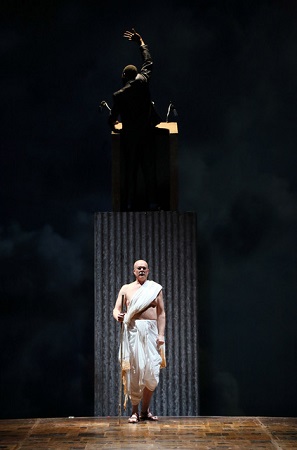 Toby Spence. Photo credit: Douglas Cooper.
Toby Spence. Photo credit: Douglas Cooper.
So to the singing, which I found to be first rate. Toby Spence, singing the role of Gandhi for the first time, was compelling in the title role. The part of Gandhi is difficult because for large sections of the opera the tenor isn’t singing - though he is on stage. Spence is undeniably impressive - he transforms from young lawyer in Act I to philosopher and emerging prophet in the rest of the opera with convincing believability. The voice isn’t stentorian (I don’t think this role really requires that kind of singing), but there is pathos, humanity and deep insight to his interpretation. He is also a formidable stage actor, which isn’t something one should take for granted with an opera singer.
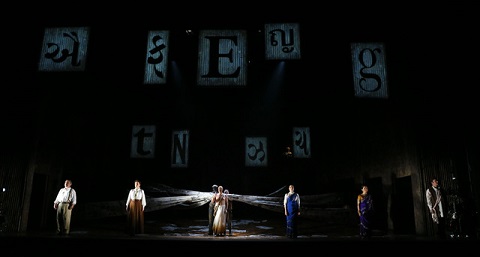 Nicholas Folwell, Charlotte Beament, Toby Spence, Anna-Clare Monk, Stephanie Marshall, Clive Bayley. Photo credit: Douglas Cooper.
Nicholas Folwell, Charlotte Beament, Toby Spence, Anna-Clare Monk, Stephanie Marshall, Clive Bayley. Photo credit: Douglas Cooper.
Commanding as Kasturbai was the Canadian mezzo, Stephanie Marshall. The voice is both huge and rich, and this was a powerful assumption of the role of Gandhi’s wife. Charlotte Beament, as Miss Schlesen, Gandhi’s secretary, sounded a touch tentative at first but her brilliant and bright soprano was able to cut through the orchestra like glass. The composer is rather merciless in his demands for this particular role, since so much of it lies in the upper registers of the voice, but Ms Beament was often breath-taking, and her soprano is fresh enough to hold those high notes without the notes cutting short. By any standards, this was outstanding singing. Andri Björn Róbertsson, as Lord Krishna, sang magnificently, but was less compelling to watch I’m afraid. Nicholas Folwell as Mr Kallenbach seemed less secure when singing solo, where the voice appeared small, than he did when singing as part of an ensemble, where he largely excelled.
Karen Kamensek, the conductor, is something of a Philip Glass specialist, and it showed. Her command of the score was almost absolute, and she obtained from the Orchestra of English National Opera playing that was meticulous, sumptuous and impressively coherent. It’s one thing to get the notes in something like the right order; it’s quite another to make this score sound as deeply involving and as profound as Ms Kamensek achieved here. This was a major achievement for her and the ENO orchestra, who should probably now be considered one of the leading opera orchestras for Glass’s major works.
ENO’s Satyagraha was a major operatic landmark when it was first performed over a decade ago. It is still that - and absolutely unmissable.
Marc Bridle
Philip Glass: Satyagraha
Toby Spence - M. K. Gandhi, Charlotte Beament - Miss Schlesen, Anna-Clare Monk - Mrs Naidoo, Stephanie Marshall - Kasturbai, Nicholas Folwell - Mr Kallenbach, Sarah Pring - Mrs Alexander, Eddie Wade - Prince Arjuna, Clive Bayley - Parsi Rustomji, Andri Björn Róbertsson - Lord Krishna, Skills Ensemble; Production: Director - Phelim McDermott, Associate Director & Set Designer - Julian Crouch, Revival Producer - Peter Relton, Costumes - Kevin Pollard, Lighting - Paule Constable, Video - Leo Warner, Mark Grimmer (Fifty Nine Productions),English National Opera Orchestra & Chorus, Karen Kamensek (conductor)
ENO, The Coliseum, London; 1st February 2018.
image=http://www.operatoday.com/ENO%20Satyagraha%20%28c%29%20Donald%20Cooper%20%281%29.jpeg image_description=Satyagraha, English National Opera product=yes product_title=Satyagraha, English National Opera product_by=A review by Marc Bridle product_id=Above: Toby Spence and ENO company, SatyagrahaPhoto credit: Douglas Cooper
Mahler Symphony no 8—Harding, Swedish Radio Symphony Orchestra
To understand it, we need to listen in terms of Mahler himself, ditching the baggage of preconception that's piled up, blocking closer evaluation. What is M8 about, and how does it fit in the context of Mahler's work as a whole ? "Veni Creator spiritus !" and "Accende lumen sensibus". Come, spirit of creation, arise, light of sensibility. Mahler makes it pretty clear that these ideas matter for they are embedded in the music as well as the text. Throughout Mahler's entire oeuvre, he develops ideas of transformation and creative renewal. Ignore that and ignore the whole point of his music. We need to ditch the idea of Mahler as Party Rally bombast. Sure, the orchestra's big, and there are five soloists and four choirs, but that's the irony. As so often in Mahler, it's the quiet moments that are most personal and significant : the moment when the individual comes to terms with the cosmos.
Structurally, Mahler's Symphony no 8 throws conventional listening off-balance. Conceptually, the symphony is radical because it contradicts straightforward assumptions. The two parts don't seem to connect, there's no narrative and the voices do not represent "roles" but function as much more abstract extensions of the music and the ideas within it. And that silence at the beginning of the Second Part gets misunderstood because it is silence, which minds attuned to blast and noise cannot comprehend. Though I'm a voice person, over the years I've come to realize that the silence,and the quiet introduction that follows, is the true soul of the symphony. Like the Consecration in a Catholic Mass, the most important part of the ceremony comes when the singing and praying stop, and the mystery of transubstantiation takes place. You don't need to believe that God becomes one with mankind, or even in God, but the idea of miraculous transfiguration is so powerful that it is a metaphor for Creation itself. "Veni, creator spiritus".
Daniel Harding's Mahler 8 with the Swedish Radio Symphony Orchestra is immensely rewarding, particularly if you know Mahler well. It is also an ideal performance for those who don't "get" Mahler 8 otherwise. Because the Berwaldhallen in Stockholm isn't a great monster of a hall, it favours a much more intimate atmosphere. Everyone is up close together : it feels as if everyone knows everyone, which is important since music is meant to be heard in the company of other people On the video, the cameraman pans over the chorus which is annoying if you're following the soloists, but that makes sense, when you think of the performance as an expression of the community In so many ways, the Eighth is Mahler's secular Mass where a multitude come together for a communal purpose which is fundamentally private. Thus the significance of the silvery chord in the beginning of the second part, which almost exactly replicates the bell which announces the beginning of the miracle of Consecration. As so often in Mahler, details count, like the piccolos, the triangle, the glockenspeil, the celesta and the mandolin, which as in Mahler Symphony no 7 may represent the lute of a solo musician serenading unseen and unknown. Here they can be heard clearly, instead of being overwhelmed by big blasts of sound. The Swedish Radio Symphony Orchestra has a lovely, mellow sound which suits the idea of "light". The warm glow of benevolence, rather than the blinding glare of, say, searchlights and interrogation.
The soloists were Hanna Husahr, Lise Lindstrom,Susanne Bernhard, Karen Cargill, Marie Nicole Lemieux, (one of my favourites), Simon O’Neill, George Humphreys,and ShenYang. They always get listed because they are soloists, but what matters most is the ensemble and the way they interact with the orchestra and each other. Like the anchorites in the painting that apparently inspired Goethe's vision, they are embedded in the landscape. The choirs were Swedish Radio Choir, Eric Ericsons Kammarkör, Mikaeli Kammarkör, St Jacobs Kammarkör and the Barnkör. I liked their singing a lot because it felt spontaneous, rather than over-polished: very much a coming-together of good, ordinary people who care about what they do. The children's choir were delightful : so nice to see kids behaving naturally, as kids should, their eyes shining with wonder.
Anne Ozorio
image=http://www.operatoday.com/00AK0344-%C2%A9Julian-Hargreaves-2017-resize-1-1024x683.png
image_description=Daniel Harding [Photo © Julian Hargreaves]
product=yes
product_title=Gustav Mahler : Symphony no 8 : Daniel Harding, conductor, Swedish Radio Symphony Orchestra, Hanna Husahr, Lise Lindstrom, Susanne Bernhard, Karen Cargill, Marie Nicole Lemieux, Simon O’Neill, George Humphreys, ShenYang Swedish Radio Choir, Eric Ericsons Kammarkör, Mikaeli Kammarkör, St Jacobs Kammarkör, Barnkör, Berwaldshallen, Stockholm streamed live 2nd February 2018
product_by=A review by Anne Ozorio
product_id=Above: Daniel Harding [Photo © Julian Hargreaves]
Wigmore Hall Schubert Birthday—Angelika Kirchschlager
A beautiful Namenstaglied D695 (1820), where the lines rock gently, almost more lullaby than Lied. it was written for one of Schubert's friends, Josefine Koller, who wanted to sing it to please her father. Not many singers can do artistry without artifice, but that genuine sincerity is one of Angelika Kirchschlager's great strengths. She can create youthful freshness like no-one else with the agility and purity of her timbre, yet can also warm that sweetness with a promise of innocent sensuality. In the context of those times, it was accepted that child-like beauties would grow into women, hopefully fulfilled by love. In reality, of course, things don't always work out right, so even happy Lieder can be haunted by a sense of unease. Thus Frühlingsglaube D686b (!820, Johann Ludwig Uhland) All things change, but, importantly, "Das Blühen will nicht enden". So have faith in Spring, for change is also endless renewal. In Geheimes D719 (1821,Goethe), a young person learns that love isn't easy, but in Im Frühling D882 (1826) the artist yet again finds solace in hope. Ironically, that song sets a text by Ernst Konrad Friedrich Schulze (1789-1817) whose obsessive love for two sisters wasn't romantic, as the love existed only in his mind. Bei dir allein ! D866 (?1828, Seidl), Lambertine D301 (1815 anon) and Am Bach im Frühling D361 (?1816, Franz von Schober) combined well, as did the next set : Ganymed D544 (1817, Goethe), Wiegenlied D489 (1816 anon). But with In der Mitternacht D464 (1816 Johan Georg Jacobi), a sense of doom intruded, preparing us for Erlkönig D328 (1815, Goethe) that masterpiece of Gothic horror. Since it sits fairly low, it's usually the preserve of male voices. Kirschschlager, however, made it work, since, for a change, we could hear it from the perspective of the terrified child.
Schubert himself blossomed early, reaching peaks early in his youth, dying before autumn set in. Gesang der Norna D832 (1825, Walter Scott) and Romanze zum Drama Rosamunde D797/3b (1823 Helmina von Chézy) connected to other genres Schubert was interested in, followed by more classic Lieder. Songs like Suleika I D720 (1821 Goethe) and Suleika II D717 (1821 Goethe) are Kirchschlager specialities, which suit her ability to create girlish charm tinged with tragedy. Her self confidence renewed, she sang with the warmth and sincerity that is her forte. Wigmore Hall Schubert Birthday concerts are far too high profile to cancel unless you're in extremis, which Kirchschlager was not. But Wigmore Hall audiences know Kirchschlager so well, and have heard her so often over the years, that we appreciate what she does. Singers are not machines. We understand the Liederabend ethos. Singers are singers, not machines. In Schubert's time, people didn't demand CD perfection, they cared about the singers as human beings. It's the Liederabend ethos. Kirchschlager and Drake rewarded us with classics like An den Mond D259 (1815 Goethe), Der Jüngling an der Quelle D300 (?1815 Johan Gaudenz von Salus-Seewiss), and Der Wanderer an den Mond D870 (1826 Seidl).
Finding joy in art, Schubert seems to have made light of his troubles, but we cannot help but ponder what might have been in his soul. Listening to Der Unlückliche D 713 (1821 Karoline Pichler) we can perhaps glimpse intimations of something beyond conventional Romantic morbidity. Yet the song responds to gloom by speeding up and pushing forwards: "Du hast geliebt", and later "Zerrissen sind nun alle süssen Bande". At moments, Drake's pounding forcefulness serves good purpose. In Lied des Florio D857/2 (!825, Christian Wilhelm von Schütz), we return to calm, "erst mit Tönen sanft wie Flöten". But this sleep is poisoned. Here Kirchschlager was at her peak again, with beautiful timbre and phrasing. The recital ended with Abschied von der Erde D829 (1826) The text comes from a play, Der Falke, written by teenage poet Adolf von Pratobvera von Weisborn as a gift to his father. Strictly speaking it is not a Lied at all. The voice part is declaimed, not sung, against a piano backdrop. As the last song in the Wigmore Hall complete Schubert song series, it's an extraordinarily moving moment. We remember that Schubert died in his prime, his voice silenced before its time, the piano lingering to remind us of its loss.
Anne Ozorio
image=http://www.operatoday.com/Angelika%20Kirchschlager%20%E2%88%8F%20Nikolaus%20Karlinsky%205.png
image_description=Angelika Kirchschlager [Photo © Nikolaus Karlinsky]
product=yes
product_title= Franz Schubert: Lieder—Angelika Kirchschlager, Julius Drake, Wigmore Hall, London 31st January 2018
product_by=A review by Anne Ozorio
product_id=Above: Angelika Kirchschlager [Photo © Nikolaus Karlinsky]
February 4, 2018
A Splendid Italian Spoken-Dialogue Opera: De Giosa’s Don Checco
But I am glad I was sent this world-premiere recording of what was, in his lifetime and beyond, his best-known work, a comic opera from 1850, in which the title role (and only that role) is in Neapolitan dialect. De Giosa was a student of Donizetti, and Don Checco shows that he learned great things from his teacher and added touches of his own.
The recording was made in July 2015, during one or more performances at the Valle d’Itria Festival in Martina Franca (an important town, close to Bari but located inland). The Festival presents several forgotten operas every summer. Its head is Fabio Luisi, well known to Americans during his years as principal conductor of the Met (beginning in 2011). Recent and upcoming works have included rarely performed operas by Handel, Vivaldi, Piccinni, Meyerbeer, and Vaccaj (the latter’s Giulietto e Romeo). Shorter and smaller-scale works (e.g., Puccini’s Gianni Schicchi and Monteverdi’s Il ballo dell’ingrate) are performed in the cloisters of the nearby eighteenth-century church of San Domenico.
The life of Nicola De Giosa is nicely summarized in the informative booklet-essay by musicologist Dinko Fabris. The English translation of the essay is comprehensible, if not always idiomatic. The plot summary given in the booklet is likewise very helpful. I easily downloaded the libretto and translation from dynamic.org and found that these helped me a lot, especially in extended passages of spoken dialogue. Again, the translation (uncredited) is sometimes misleading: Don Checco does not enter “very poorly dressed” (which might suggest an outfit inappropriate to the occasion); rather his clothes are those of someone who is utterly impoverished (meschinissimo)—that is, his outfit is in tatters. The track list in the booklet is also misleading because it often mentions only the first character who happens to sing.
I said that there are extensive passages of spoken dialogue. This was true of all operas written for the Teatro Nuovo in Naples. (Operas composed for other houses had their recitatives turned into speech when performed at the Nuovo; and vice versa: Don Checco was done with recitatives when performed elsewhere in Italy.) The use of spoken scenes between the sung numbers brings Don Checco close in spirit to French opéra-comique, Viennese operetta, and Gilbert and Sullivan (and thus to their offspring, the Broadway musical). For another example of Italian opera with spoken dialogue, I heartily recommend Adelson e Salvini (1824), a surprisingly strong opera written by the 23-year-old Vincenzo Bellini, during his graduation year at the conservatory in, yes, Naples. (A first-rate new recording of Adelson e Salvini—with major singers, including the tenor Enea Scala—is the first to make use of the forthcoming critical edition. It is reviewed here at Opera Today by Claire Seymour and, at the Boston Musical Intelligencer, by myself.)
The libretto from Dynamic states that the singer of the title role has improvised some of his dialogue. I suspect that he is not the only one adding lines. For example, the innkeeper Bartolaccio (a nickname, something like Big Fat Bartholomew) vents his annoyance in spoken exclamations over the orchestral postlude to Act 1, scene 2, as the chorus of male villagers leaves his inn. This helps smooth the transition to the beginning of scene 3. Even more amusing: on two occasions a musical number is interrupted (in the middle of a cadential phrase!) by a bit of what seems to be invented spoken dialogue; then the singing and orchestral playing resume, to bring the number to a close.
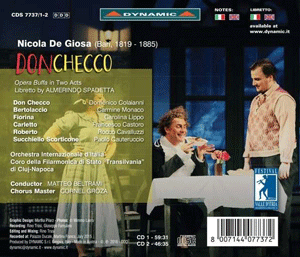
De Giosa’s music is a constant delight. After a five-minute stretch of rapid-fire spoken exchanges, the re-entry of orchestra and singing always feels like a welcome moment for emotional expansion. Often the dramatic impetus that has been set up in speech continues into the next musical number, thanks to the skillful (and witty) libretto and to De Giosa’s skillful ways of contrasting the reactions of the different characters.
The orchestration is finely crafted. I particularly enjoyed the music for the bassoon and shivering strings when Don Checco first enters and declares: “I’m freezing to death!” My ears also perked up at a few points when the composer creates back-and-forths between the winds and strings (e.g., at the end of Don Checco’s introduction to his final song). The highlight of the second act is a duet in which the two bassi buffi (Don Checco and the innkeeper) vie to outdo each other in rapid patter, against an enchanting dancelike tune in the orchestra. The effect is all the more amusing because their patter involves comical leaps of an octave. One can see how De Giosa’s good ear for vocal effects and instrumental colors helped him get chosen to conduct in prominent opera houses—not just in Italy but also in Cairo (at the theater where Aida received its world premiere) and Buenos Aires.
The singers, all Italian and all previously unknown to me, have firm, focused voices—nary a wobble to be heard here. (Except at times from Bartolaccio, the grumpy innkeeper, but a somewhat worn voice seems appropriate for a character who is a bit old.) All enunciate the humorous text clearly and with appropriate variety. The extensive spoken dialogues gave me great occasion to be thankful that the singers are native Italian-speakers. The interchanges flow swiftly and naturally, and I was able to recognize many words and phrases by ear alone. A few spoken lines have been updated to the era of the costumes (see below): there are pointedly humorous references to Chanel cologne and to film-actress Gina Lollobrigida, and one new bit is directed to the opera’s conductor! (The libretto reproduces and translates the words that we hear sung and spoken; the listener is nowhere informed that updatings have been made.)
The audience members, to judge by their laughter, clearly loved Domenico Colaianni, who gives Don Checco not just a heavy Neapolitan accent but also a shifting variety of moods: hangdog, wheedling, fake-pompous, and so on. Still, since I was not able to fully appreciate the nuances of his character’s Neapolitan dialect, I responded more to the young lovers. Carolina Lippo sings the pert and savvy Fiorina (the innkeeper’s daughter) with effortless command. Francesco Castoro, as her timid young lover (a waiter in her father’s inn), has a voice that, when he is singing alone, is often beautiful and with wonderful “ping” but, in an ensemble, tends to sound tight and devoid of specific character.
I imagine that the ducal-palace courtyard seats hundreds of listeners, rather than the thousands in many modern opera houses. This would explain how the singers are able to make their points without ever having to force their voices. I have been told that the palazzo courtyard is unroofed. Honors to the engineers for having nonetheless captured the sound so vividly!
The festival orchestra—mostly Italians—is decent-sized, sonorous, and totally effective. The score calls for the normal Italian comic-opera orchestra of the time (including pairs of clarinets, bassoons, horns, trumpets, and trombones, plus a cimbasso, whose part is presumably played here on the tuba). The passages for the chorus of villagers (men only) are superbly sung, with good sense of involvement in the action, by a group from Romania.
Conductor Beltrami keeps things moving, even in more lyrical numbers. He contributes some elegant orchestral phrasing: for example, tapering a series of repeated chords, instead of hammering them all at the same or, worse, increasing volume.
Indeed, the sonics of this recording are better than those on some recordings, of equally recent vintage, that were made in a radio studio or empty concert hall. (See my complaints, in reviews on this site, about Karine Deshayes’s recital of Rossini arias and songs and soprano Emalie Savoy’s debut CD.) The sound can get a bit congested at moments when everyone on stage is singing out, but any such problems pass quickly.
An appreciative review of this same Martina Franca staging of Don Checco (but a year earlier, 2014, and with different singers and conductor) can be found at Bachtrack.com. It contains two photos of scenes from the production that helpfully complement those in the CD booklet. As the various photos show, the sets and costumes were updated to the mid-twentieth century, but they otherwise represented precisely what the libretto specifies: “a village inn not far from Naples.” There were no so-called imaginative or postmodern directorial touches to get in the way here, such as moving the opera to an impoverished favela in the hills above modern-day Rio de Janeiro, or to a penal colony on the moon after a nuclear apocalypse.
On YouTube, two of Don Checco’s arias can be heard, performed in a different city (De Giosa’s hometown, Bari, 2013) by a different baritone (the one who sings the innkeeper on the CD set). YouTube also has a video excerpt of the song with which Don Checco closes the opera (from the Martina Franca production, but sung by yet a third baritone: Bruno Taddia).
Since a conductor-musicologist (Lorenzo Fico) went to the bother of preparing an edition of the score for these various revival performances (Bari and Martina Franca), it would be wonderful if some publisher would make that edition available in print, enabling us to savor the full extent of De Giosa’s artistry. And, while I’m placing my order, why not also a piano-vocal reduction to facilitate staged performances and to enable arias and duets to be done in voice recitals? I would suggest that the publisher include, as an alternative, recitatives (preferably historical or, if those do not exist, newly composed), to make life easier for singers who cannot speak dialogue convincingly in Italian and Neapolitan. Much of the work’s charm and local flavor would still survive through such a transmutation.
De Giosa composed fifteen or more other operas, several of them serious. Are any of them as effective as Don Checco? I hope some Italian theater or summer festival tries to find out, and that Dynamic records the result as neatly and capably as they have done here.
If you have access to the Naxos Music Library—say, by subscribing on your own or through a public or university library that subscribes—you can listen to this recording. You can also download the libretto there for free, by clicking on the word Booklet. Oddly, the actual CD booklet, with Fabris’s enormously helpful essay, is not available online.
All in all, this comic opera and its spiffy recording offer much unexpected pleasure, as well as food for thought about what features made a work successful in its own time and place and what features (and alterations) might enable it to communicate across the centuries and across cultural and linguistic barriers.
Ralph P. Locke
The above review is a lightly revised version of one that first appeared in American Record Guide and appears here by kind permission.
Ralph P. Locke is emeritus professor of musicology at the University of Rochester’s Eastman School of Music. Six of his articles have won the ASCAP-Deems Taylor Award for excellence in writing about music. His most recent two books are Musical Exoticism: Images and Reflections and Music and the Exotic from the Renaissance to Mozart (both Cambridge University Press). Both are now available in paperback, and the second is also available as an e-book.
image=http://www.operatoday.com/8007144077372.png image_description=Nicola De Giosa: Don Checco product=yes product_title=Nicola De Giosa: Don Checco (comic opera in 2 acts) product_by=Carolina Lipp (Fiorina), Francesco Castoro (Carletto), Domenico Colaianni (Don Checco), Carmine Monaco (Bartolaccio), Rocco Cavalluzzi (Count Roberto), Paolo Cauteruccio (bailiff) . Orchestra Internazionale d’Italia and Transylvanian State Philharmonic Chorus (Cluj-Napoca), conducted by Matteo Beltrami. product_id=Dynamic 7737/1-2 [2CDs] price=$29.99 product_url=https://www.amazon.com/Nicola-Giosa-Checco-Carolina-Lippo/dp/B01C9P34Z6/ref=as_sl_pc_tf_til?tag=operatoday-20&linkCode=w00&linkId=97872555a15346b3744933f98e3e768e&creativeASIN=B01C9P34Z6
Winterreise by Mark Padmore
Padmore and Bezuidenhout, playing fortepiano, present a very thoughtful Winterreise which, in its pristine lucidity, connects extraordinarily well to the spirit of the cycle. In a winter landscape, and in darkness, you may lose your path but snow reflects what light there is. Background sounds are muffled, but what you do hear is accentuated. You may be cut off from the world, but you are enclosed within yourself. Serious listeners know every note of Winterreise but rarely experience it like this. This is an unusual Winterreise but so perceptive that it enhances our appreciation of the most familiar of all song cycles. The fortepiano may come as a surprise to audience attuned to modern performance practice, but it's leaner timbre works well with Winterreise, and especially in the critically important final song, "Der Leiermann".
The only real comparison is the iconic Christoph Prégardien's recording with Andreas Staier, released in 1997, still a classic. Winterreise devotees will need them both. Staier, one of the great fortepianists of our time, noted that, in Schubert's time, pianos were very different from modern concert grands. Staier and Prégardien performed a great deal of Schubert together, developing an approach more sympathetic to the intimate, personal Liederabend aesthetic. Schubert was himself a tenor, though of course the songs are performed in many different ways. The main thing is to be receptive to interpretation and non-dogmatic. Since the timbre of the pianoforte is more delicate, the voice part needs to connect. Like Prégardien, Padmore came from a choral background. The English tenor style favours purity and clarity, yet also lends itself well to a kind of rarefied spirituality. Not all English tenors are "English tenors"; it's a particular style. Like Ian Bostridge, Padmore can sing with an edge that intensifies darker undercurrents in meaning. In Winterreise, this is of the essence, for Winterreise is an inner psychological journey, expressed through stages describing physical landscape in almost allegorical terms. Even the destination remains a mystery. Thus the value of approaches which allude to levels in the music beyond text alone.
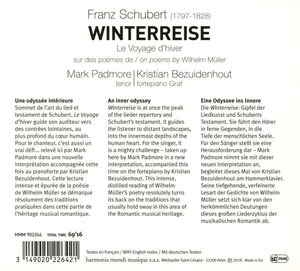 Fortepiano gives the introductory bars a tremble which suggests the nature of the chill that is to descend. The lower notes stride with purposeful definition. Padmore's voice curves. "Fremd!", he sings, rolling the "r" so it flies forth. The sharpness of his consonants in contrast with the ring of the vowels creates a tension which works well with meaning. The protagonist is entering unknown territory, suppressing his fears to journey on. For a moment, in "Der Lindenbaum", he can rest and reflect, and Padmore's voice grows more tender, and the fortepiano rocks gently. But falling asleep under the supposedly narcotic scent of linden blossom means death. In "Wasserflut", the vocal line rises and drops. Good phrasing , like "Fühlst du meine Tränen glühen, da ist meiner Liebsten Haus", Bezuidenhuit's fortepiano maintaining a steady pace. In "Irrlicht", the brightness of fortepiano and high tenor suggest the character of the will o' the wisp, flickering elusively, luring the unwary astray. In lines like "fühlst in der Still’ erst deinen Wurm, mit heißem Stich sich regen!" (in "Rast!"), the word "Wurm" here, feels satanic, diverting the protagonist from his mission.
Fortepiano gives the introductory bars a tremble which suggests the nature of the chill that is to descend. The lower notes stride with purposeful definition. Padmore's voice curves. "Fremd!", he sings, rolling the "r" so it flies forth. The sharpness of his consonants in contrast with the ring of the vowels creates a tension which works well with meaning. The protagonist is entering unknown territory, suppressing his fears to journey on. For a moment, in "Der Lindenbaum", he can rest and reflect, and Padmore's voice grows more tender, and the fortepiano rocks gently. But falling asleep under the supposedly narcotic scent of linden blossom means death. In "Wasserflut", the vocal line rises and drops. Good phrasing , like "Fühlst du meine Tränen glühen, da ist meiner Liebsten Haus", Bezuidenhuit's fortepiano maintaining a steady pace. In "Irrlicht", the brightness of fortepiano and high tenor suggest the character of the will o' the wisp, flickering elusively, luring the unwary astray. In lines like "fühlst in der Still’ erst deinen Wurm, mit heißem Stich sich regen!" (in "Rast!"), the word "Wurm" here, feels satanic, diverting the protagonist from his mission.
In "Der greise Kopf", Padmore sings the first lines with a lyricism that rings with flute-like grace, emphasizing the deathly near-whisper of "Doch bald ist er hinweggetaut". We are being prepared for the songs that follow, where the landscape becomes increasingly surreal, reflecting perhaps the psychic trauma the protagonist is facing. This is where the unique quality of the English tenor style pays off, its archness suggesting anguish. In "Die Krähe", a crow stalks the protagonist like a Doppelgänger : is it friend or foe ? In "Der stümische Morgen", Bezuidenhout's fortepiano growls ferociously, evoking the storm, both external and internal. Padmore's voice rises defiantly, but the protagonist is up against almost supernatural forces. Thus the turbulence in "Der Wegweiser" , pulling in different directions. Even the graveyard offers no solace. In "Mut!", notice the way Padmore marks the tremble in the word "herunter", while Bezuidenhouit pounds as fiercely as a fortepiano can. Now the protagonist challenges God himself. "Will kein Gott auf Erden sein, sind wir selber Götter!" In early 19th century terms, this is almost blasphemy. He looks up and sees three suns, a natural phenomenom that exists in certain climatic conditions, but he thinks they resemble three staring eyes. Is the protagonist mad or visionary ? The hushed horror in Padmore's singing suggest both possibilities.
And thus to "Der Leiermann" the climax of the whole journey. Bezuidenhout's fortepiano creates a sense of fragility, the notes sparkling the way light shines off heavy snow. Is this brightness an illusion, like the will o' the wisp ? A large, strong piano might suggest an element of hope, but a fortepiano emphasizes vulnerability. The colours in Padmore's voice turn pallid, his tone dropping as if he's watching a ghost. There are moments of light, where the voice rises like a flute, as opposed to the drone of a hurdy-gurdy. But note the steady deliberation, as if the protagonist was falling into step with the Leiermann's death march. The last word "dreh’n?" rings out like one last call into the void, and the fortepiano’s last notes shuffle, deflated. Padmore and Bezuidenhout don't present an ordinary Winterreise, and some won't get it because it is different. But it does offers good insights, even in a market teeming with excellent performances.
Anne Ozorio
Click here for excerpts of this recording.
image=http://www.operatoday.com/3149020226421.png
image_description=
product=yes
product_title=Franz Schubert: Winterreise—Mark Padmore (tenor), Kristian Bezuidenhout (fortepiano)
product_by=A review by Anne Ozorio
product_id=Harmonia Mundi HMU907404
price=$18.98
product_url=https://www.amazon.com/gp/product/B076PZWW6L?ie=UTF8&tag=operatoday-20&camp=1789&linkCode=xm2&creativeASIN=B076PZWW6L
Ilker Arcayürek at Wigmore Hall
Stravinsky may or may not even have been correct to call it a sine qua non (before, in imitable style, demolishing the claim that it was in anyway enough). Whether there is sincerity in the deliberate presentation of insincerity and in irony is, perhaps, a dialectical question for another day. (For what it is worth, I think the answer is probably ‘yes – probably’.’ Artistic sincerity is surely, however, a good starting-point, a fine way to draw the listener in. And so it was here from Arcayürek, ably accompanied by Simon Lepper, in a wide-eyed (wide-voiced?!) Frühlingsglaube, properly vernal.
The programme’s progression made sense too. Without overt didacticism there were paths, musical, verbal, thematic to follow, to make one’s one way through this Schubert recital. Musical – in this case, rhythmic – discipline enabled Mayrhofer’s song to the Dioscuri to take us further on our way, whilst the sadness of hisAbendstern shone through in voice and piano alike. In between, arastlose (restless) account of Goethe’s Rastlose Liebe likewise relied upon the freedom born of such discipline. The same poet’s – and, of course, composer’s – Am Flusse flowed nicely, without a wearisome attempt to make it into something it is not.
The Jüngling auf dem Hügel (youth on the hill) could then look down upon what we had seen, heard, experienced so far, the music the key to the words and vice versa, Schubert and his present-day collaborators winningly attentive to the alchemic balance of Lieder-performance. The death knell rang out on the piano perhaps all the more clearly, at any rate movingly, for the lack of underlining. We were trusted to listen for ourselves. Impetuous relief, then, came at just the right time with Der Schiffer, prior to a wan and worldweary Doppelgänger, Arcayürek’s voice rising to encompass fear, anger, and defiance, although never to the neglect of more ‘purely’ musical values. That such moonlit drama could shade into reminiscences of Beethoven’s moonlight in An den Mond spoke well not only of that particular performance but of the thought that had gone behind its placement. Winds and mists brought the first half to a Romantic close, vocal tone and mood their agent, yet precision too. It takes art to evoke rather than fall into the imprecise.
Der Einsame brought piano onomatopoeia (the crickets at night) from Lepper and an apt lightness of approach from Arcayürek, making me think he would be a dab hand at first-rate operetta: Offenbach, or occasional Johann Strauss. There was nothing tedious to the performance of a song which, in the wrong hands, can sometimes become just that. Pristine neoclassicism and a little second-stanza naughtiness enlivened Die Laute and its solitary lamp: a different yet related vision of night-time. Likewise Sehnsucht: another well-judged change of mood. A well shaped account of another Goethe song, Schäfers Klagelied offered typically Schubertian smiling through tears, as well as the vivid drama of actual (and metaphorical?) storm. One began to appreciate the sadness that had underlay even the earliest songs in the programme, in part retrospectively.
It may sound obvious, but to perform the Romanze from Rosauunde as, well, a romance, offered the key to its success, especially as relief after a darkly romantic indictment of ‘love’ in Die Liebe hat gelogen. Again, the clue proved to be in the title for Wer sich der Einsamkeit ergibt, Schubert extending, as perhaps only music can, Goethe’s conception of loneliness. Particularity of mood characterised both of the following Goethe songs too; so did able voice-leading: in piano, tenor, and both. The quiet dignity of Schwanengesang – the 1822 song, not the song-cycle! – and its unforced Unheimlichkeit brought genuine, not contrived silence at the close. Which returns us to sincerity: an ideal for us as listeners too?
Mark Berry
Programme:
Schubert: Frühlingsglaube , D 686; Lied eines Schiffers an die Dioskuren, D 360;Rastlose Liebe, D 138a; Abendstern, D 806; Der Jüngling and der Quelle, D 300; Am Flusse, D 766; Der Jüngling auf dem Hügel, D 702;Der Schiffer, D 536; Der Doppelgänger, D 957;An den Mond, D 193; Über Wildemann, D 884;Nachtstück, D 672; Der Einsame, D 800;An die Laute, D 905; Der Musensohn, D 764;Sehnsucht, D 879; Schäfers Klagelied, D 121;Die Liebe hat gelogen, D 751;Romanze aus ‘Rosamunde’, D 797/3b;Wer sich der Einsamkeit ergibt, D 478b;Wer nie sein Brot mit Tränen ass, D 480c;An die Türen will ich schleichen, D 479b; Schwanengesang, D 744. Ilker Arcayürek (tenor), Simon Lepper (piano). Wigmore Hall, London, Sunday 28 January 2018.

